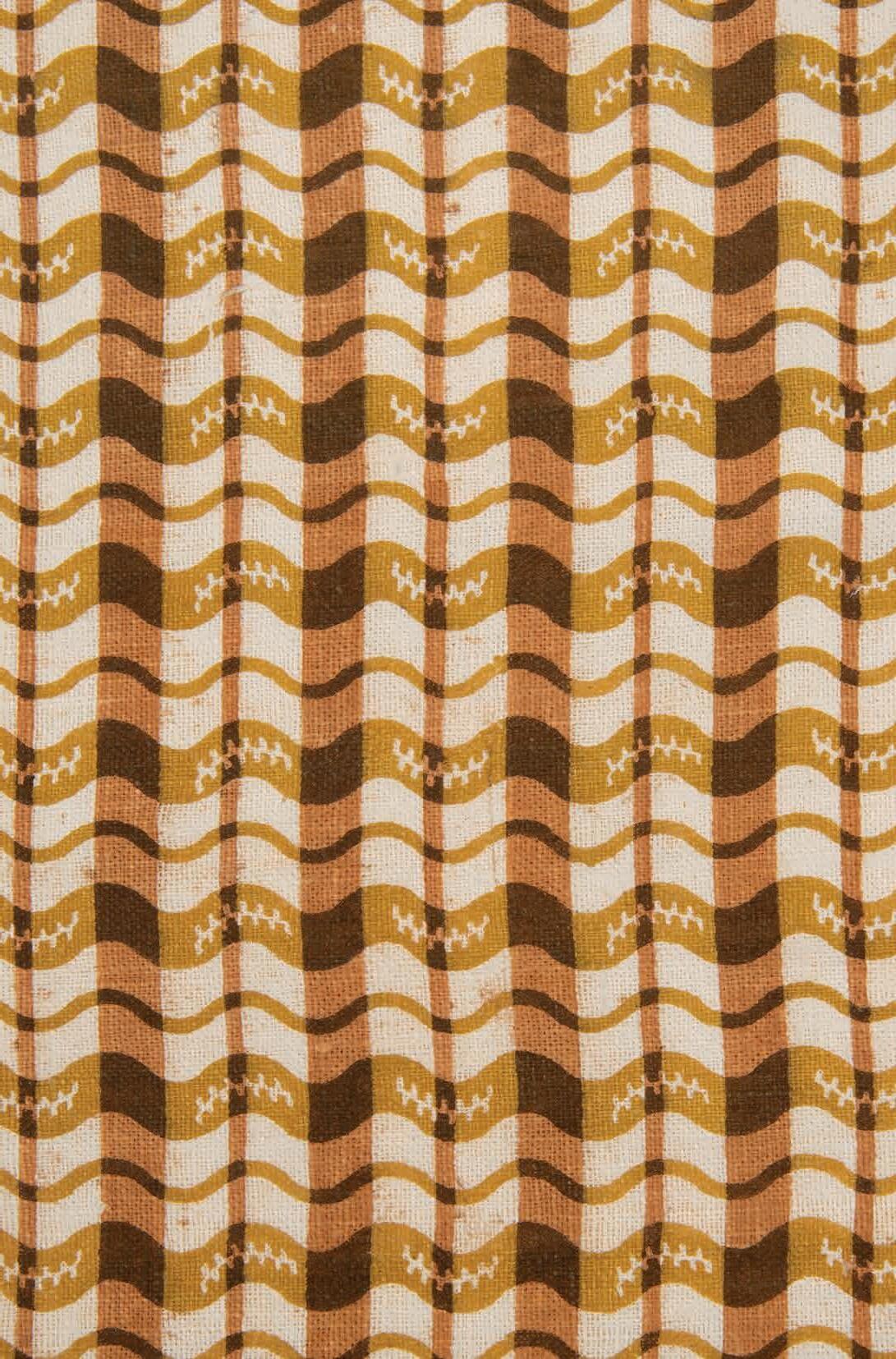CORA GINSBURG
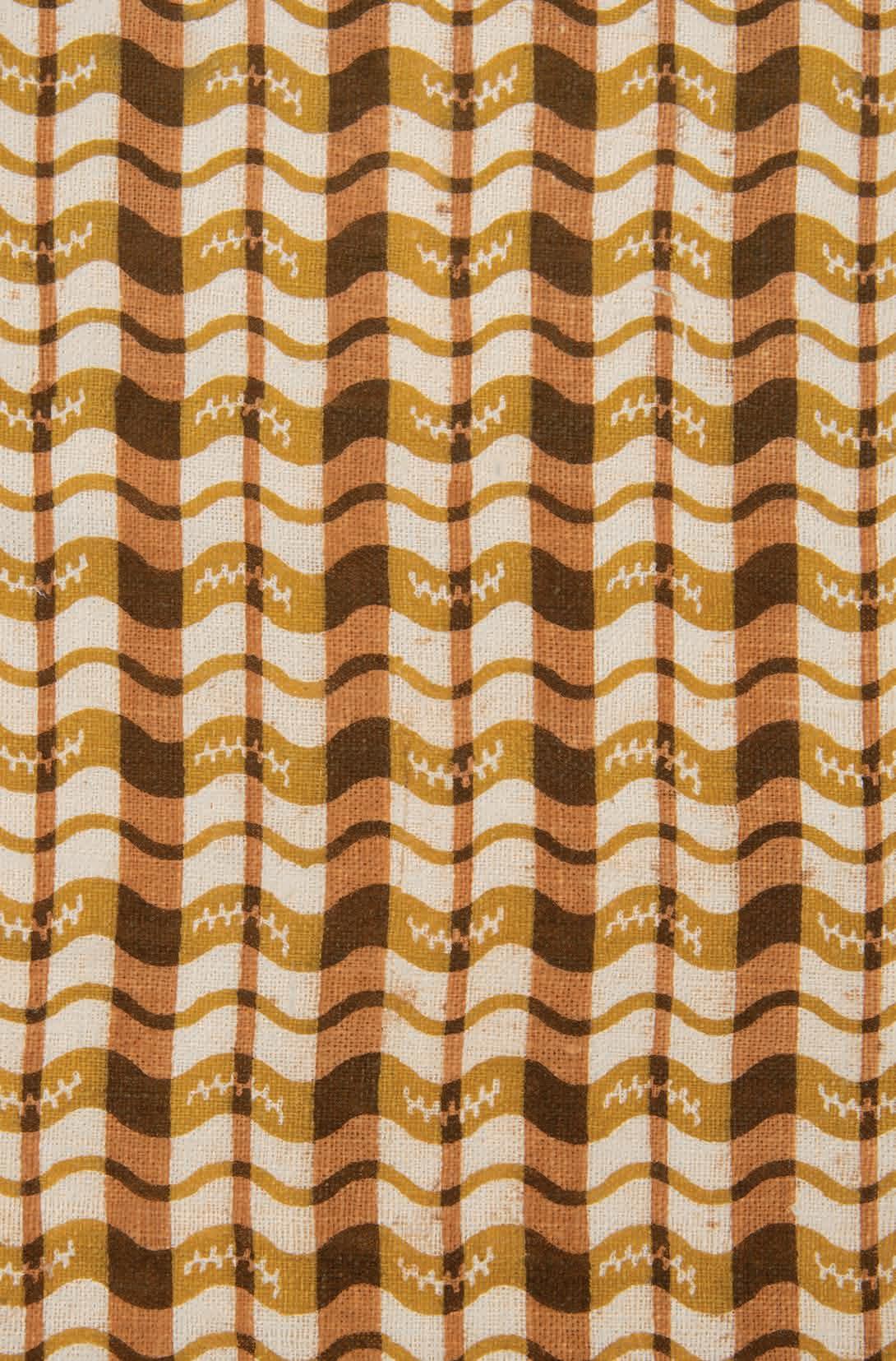
Costume • Textiles • Needlework
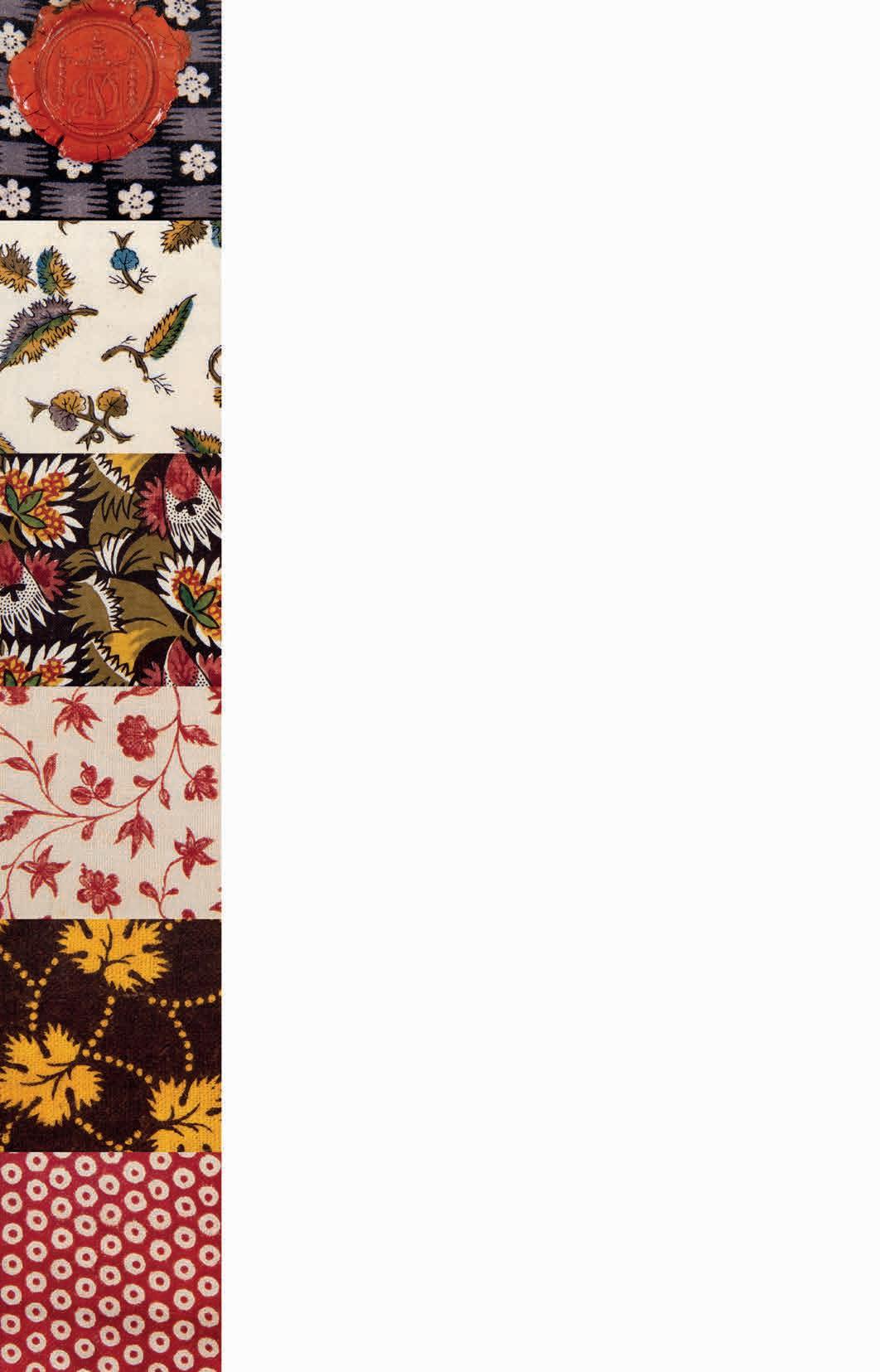
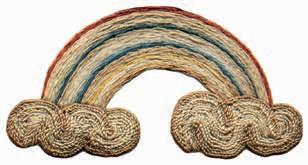
A Catalogue of exquisite & rare works of art including 17th to 19th century costume textiles & needlework 2019 TITI HALLE 19 East 74th Street New York, NY 10021 www.coraginsburg.com tel 212-744-1352 info@coraginsburg.com CORA GINSBURG LLC by appointment
BLOCK-PRINTED COTTON ROBE À LA FRANÇAISE AND RED SATIN SHOES
Probably French, ca. 1770–75
Passed down from mother to daughter for generations, this complete robe à la française—with coordinating red satin shoes—is not only a well-documented family relic, but also an exceptionally preserved index of late rococo European fashion. Marrying an informal textile with a stylized court mode on the wane, the dress’s hybridity exemplifies the progression of French fashion toward ease and comfort as the eighteenth century advanced.
Comprising an unaltered robe, or manteau, and a matching petticoat, this dress is made of a textile known as indienne, a cotton cloth printed in Europe using mainly direct impression dyeing methods, imitating the painstaking painted-and-resist-dyed chintzes produced in India, which were banned in France from 1686 to 1759. A pattern of serpentine stems sprouting whimsical flowers, some almost insect-like, is inspired by the designs of Jean-Baptiste Pillement, whose collections of chinoiserie engravings were widely influential across Europe throughout the second half of the eighteenth century, particularly for printed cottons.
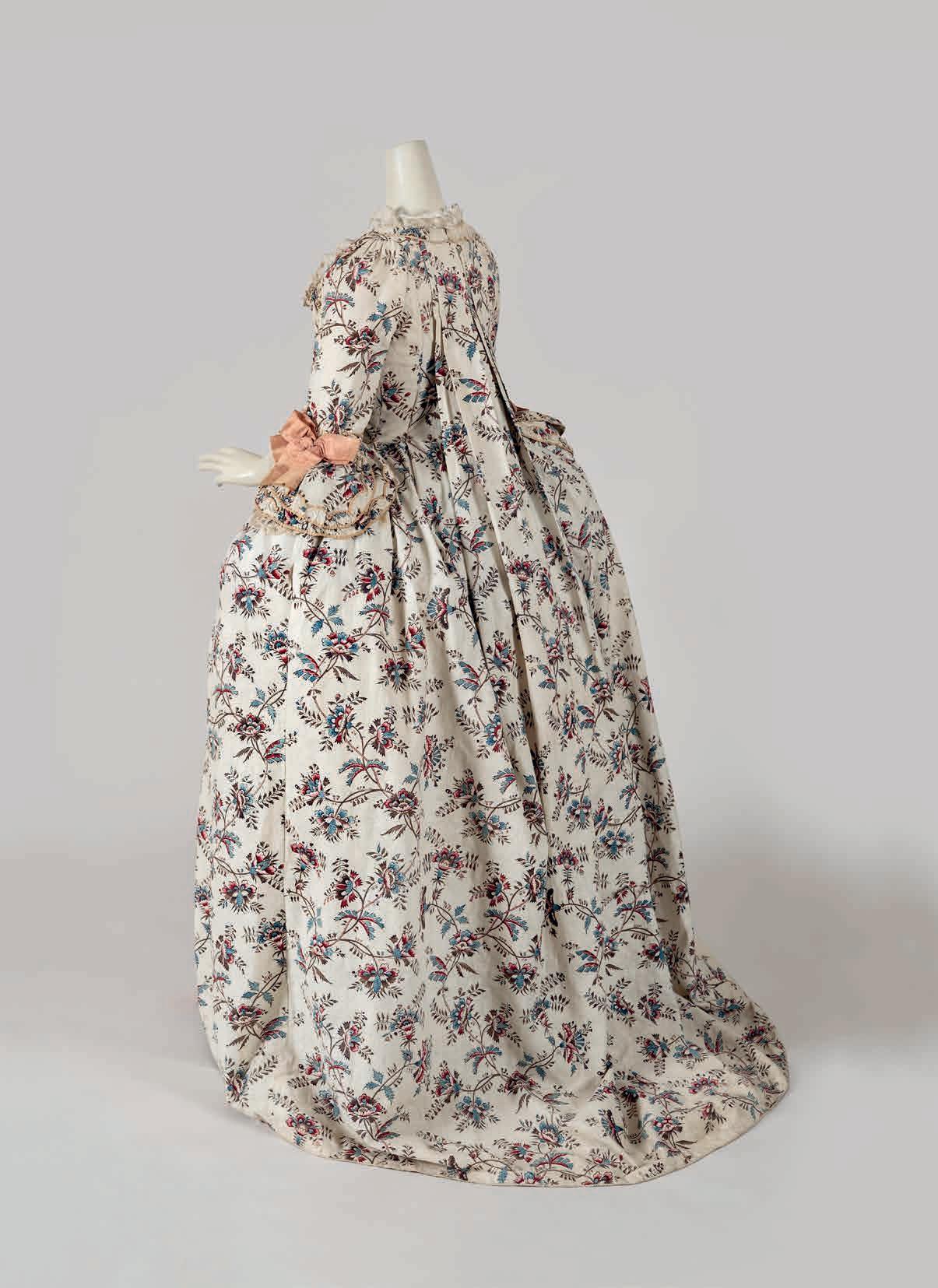
The influence of chintz is most evident in the white, geometric filling patterns decorating select blue areas of the design, which mimic the complex undyed areas created by Indian artisans using wax. In France, as explained by M. Delormois in the 1780 edition of his popular L’art de faire l’indienne, printers applied a mixture comprising gum arabic, starch, turpentine, tallow, and pipe clay, boiled with water, to block print resist patterns onto the ground fabric, over which indigo dye was then applied, either by vat immersion or, as here, by hand. First developed in England in the 1730s, penciling (pinceautage in French) allowed small areas of blue to be laid on directly with a brush by preparing a ferrous-sulphate solution of indigo, thickening it with gum, and adding orpiment, an arsenic reducing agent. This kept the indigo undeveloped long enough for it to be quickly painted over the resist pastes, which were then washed out. A similar technique was used to apply small areas of yellow over blue, creating a green shade.
While family lore indicating that the dress was worn at the court of Maria Theresa in Vienna is impossible to corroborate, the form of the dress itself certainly borrows from the regal criteria of court attire, with double drawstrings at the hips allowing a rectangular expansion of nine inches on either side, sustained by oblong panniers.
This formality could be tempered by drawing up the trailing skirt at the back into the style of a robe à la polonaise, transforming a prescribed court silhouette into one associated with the “practical” concessions made by idealized working-class women, such as shepherdesses. Pink silk ribbons sewn to the interior and exterior waist join with their original eighteenth-century hooks and eyes, allowing the skirt to be raised. In this case, the drawstrings at the hips would be pulled tight, and the hoop below changed, in order to create a rounder shape. As this softer, more casual silhouette became increasingly desirable, so too did sleeves dispense with the double- and triple-flounced cuffs fashionable since about 1750, here weighted with two unusually heavy linen-covered metal discs, a further vestige of court etiquette. The compère (false waistcoat), closing with self-fabric buttons rather than a separate stomacher, is a final shift to a more relaxed mode of dress.
Complete robes à la française of printed-cotton indienne are exceptionally rare. Comparable French examples include those at the Metropolitan Museum of Art (C.I.64.32.3ab) and the Palais Galliera (GAL1920.1.555AB). Despite a tantalizing glimpse of double registration lines indicating the edge of a large chef de pièce across the center back of the petticoat, an identification with any particular textile factory remains elusive, as designs migrated frequently throughout France and across borders, particularly to Switzerland. A caraco of similar printed cotton, attributed to a French manufactory, is illustrated in the 2018 book Indiennes: un tissue révolutionne le monde! Helen Bieri Thomson, cat. no. 18.
Provenance: This dress descended to Wilhelmina Marguerite de Thiery (1900–1980), member of a family originally from Lorraine that had settled in Fiume on the Adriatic coast. She fled to the United States via Portugal in 1940 onboard the SS Exeter, bringing the dress and shoes with her. Photographs of both Wilhelmina and her daughter Doris modeling the dress accompany it, but the garment’s unspoiled state of preservation verifies the respect in which it has been held for centuries.
2
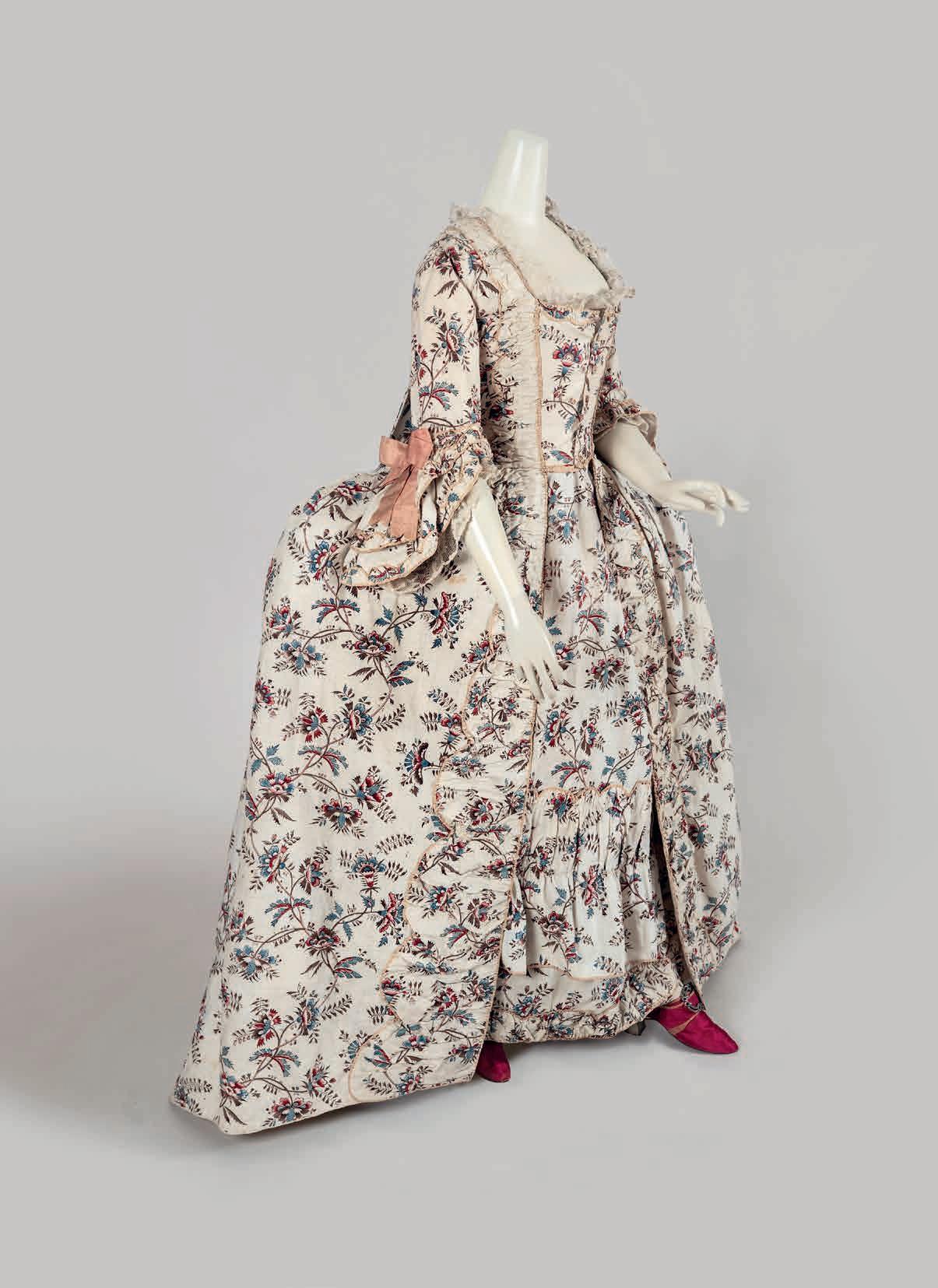
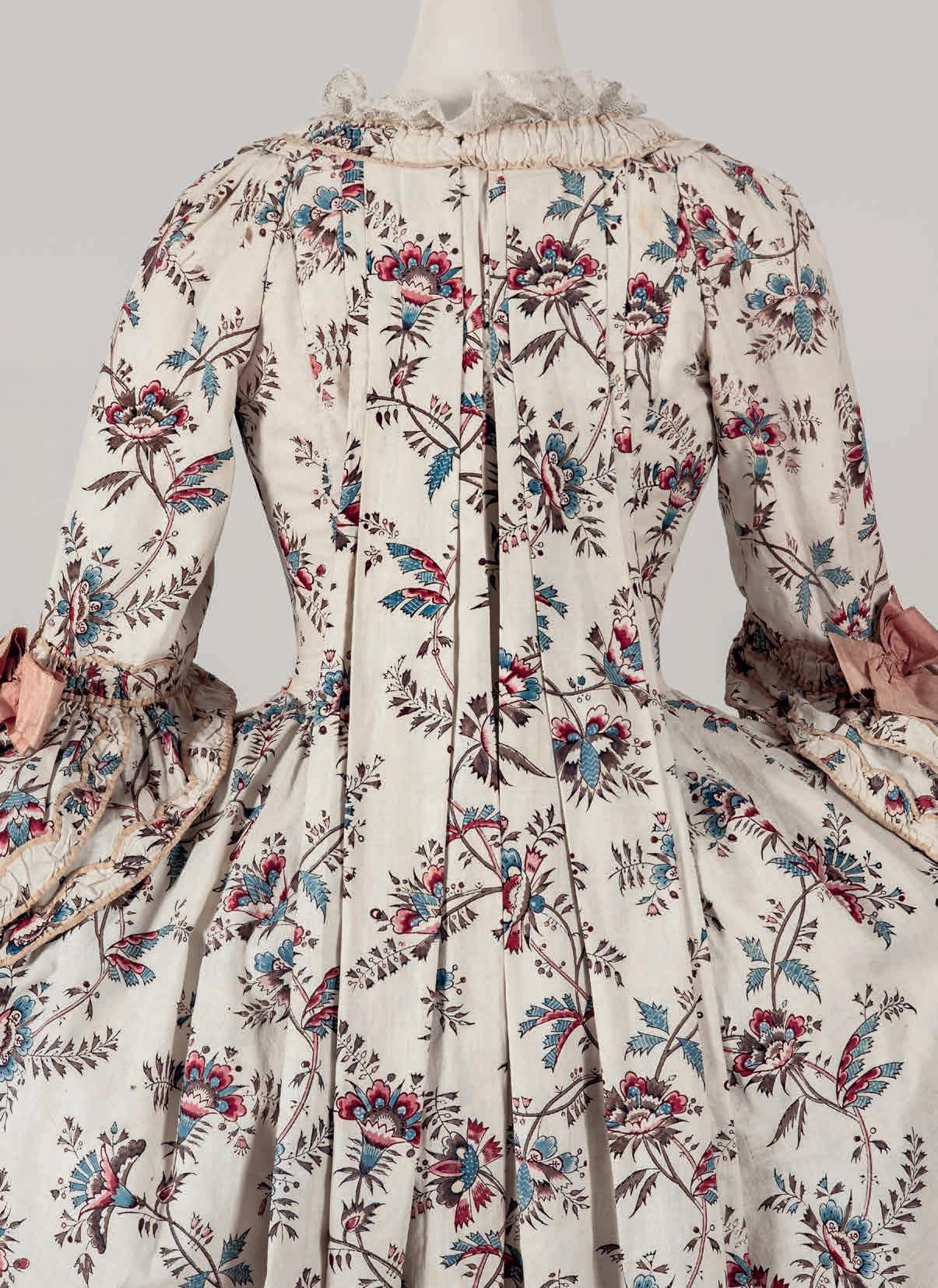
SILK VELVET AND TAFFETA SMOKING SUIT
French or British, ca. 1870
Throughout the nineteenth century, smoking was associated with masculinity and male sociability. Dedicated smoking rooms, often with orientalist-inspired decor, in private residences and men’s clubs, created environments in which smokers could retreat from the demands of the public sphere and enjoy camaraderie, conversation, and, above all, the beneficial contemplative state that the consumption of tobacco was thought to induce. In domestic interiors, the elite smoker demonstrated his individuality and sophistication through his choice of tobacco, pipe, cigar, or cigarette, as well as his luxurious attire. Like earlier forms of at-home wear, smoking suits and jackets provided upper- and middle-class men the opportunity to indulge in colorful silks and patterned fabrics, in contrast to the dark, understated wools worn for both day and evening.
Devoid of applied trimming, the brilliant peacock-blue silk velvet of this custom-tailored smoking suit commands full attention. An iridescent effect results from the golden-yellow silk ground weave, just visible along the center-front edges and the top of the slit pockets. The coordinating blue-andblack changeant silk taffeta roll collar and cuffs complement the light-reflective qualities of the lustrous pile. In its cut and construction, this suit is similar to the loose-fitting lounge suit introduced in the mid-nineteenth century as an informal alternative to the tightly buttoned frock coat. The slightly dropped placement of the jacket’s shoulder seams and the full, tapered trousers date the suit to about 1870. At the back of the waist, the metal buckle stamped “Paris” securing the half self-belt may indicate a French attribution, although nineteenth-century British tailors used imported fastenings and notions. By the 1880s, in the more “democratized” American clothing industry, ready-made silk smoking jackets at different price points were available at department stores and through mail-order manufacturers for middle-class consumers who wanted to emulate the lifestyle of their social superiors.
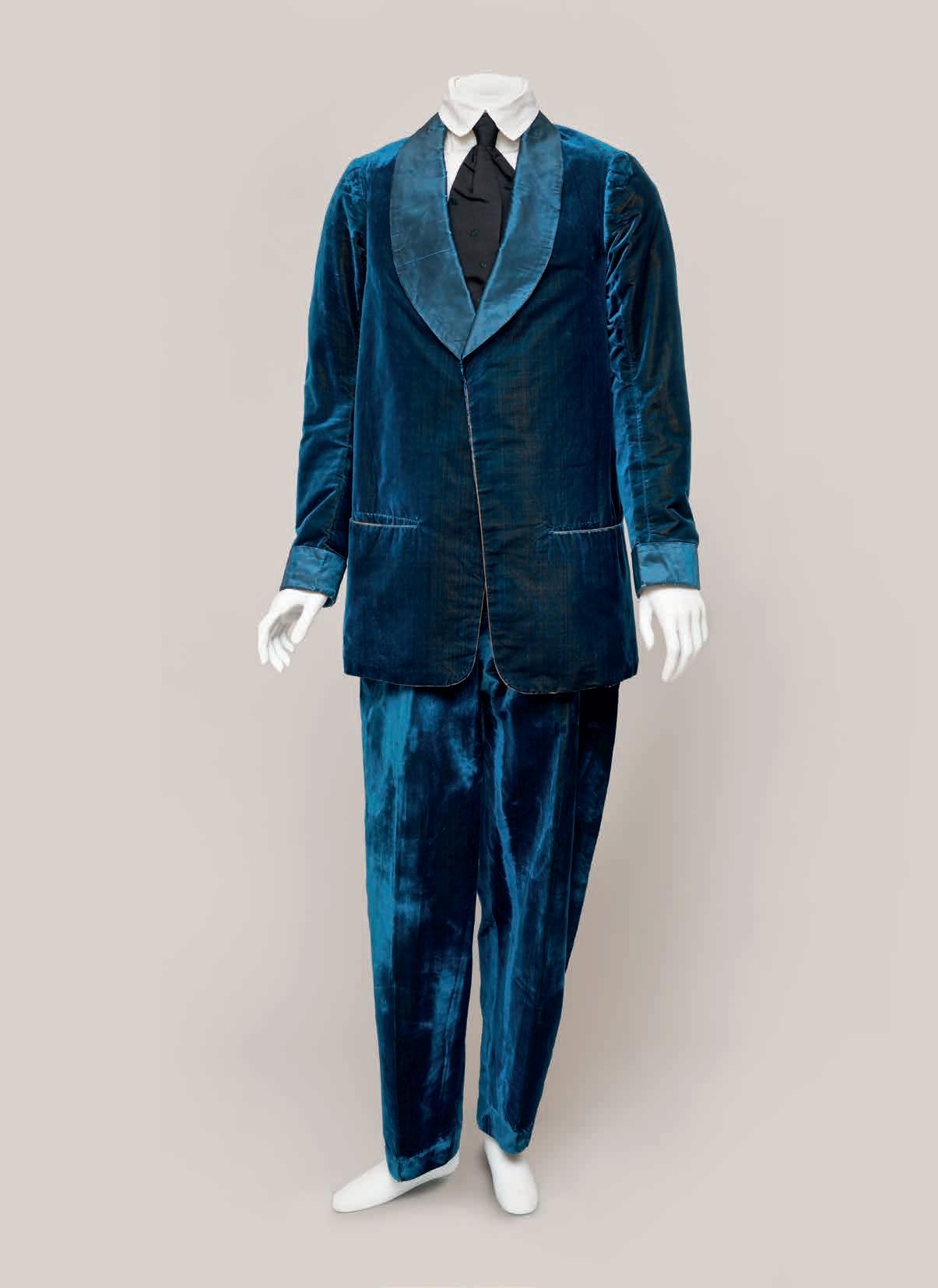
Men’s fashion magazines from the late 1860s and early 1870s attest to the popularity for velvet faced with taffeta or satin for at-home jackets. A February 1867 illustration from Le Progrès includes a male figure holding a pipe and wearing a double-breasted velvet jacket with a diamond-quilted silk roll collar, decorated with braid frogging. The March 1873 issue of The West End Gazette illustrates “an elegant breakfast jacket,” similar to this one in its overall shape and lack of closure. Identified by the editor as “a very useful adjunct to a gentleman’s wardrobe,” it was made of “black Genoa velveteen or silk velvet” with roll collar and cuffs of “blue silk, quilted in diamonds.”
References to smoking suits in late nineteenth-century British fiction convey the vogue for velvet among fashionable swells and the strict etiquette that demarcated public and private dress. In an 1883 short story titled “The Eve of St. Partridge,” a self-important, mustachioed “lady killer” wagers his friends that he will win the affections of a female guest at their house party: “And very good-looking he certainly was in his blue velvet smoking suit with its ruffles of old point.” The 1887 novel Nant Olchfa by E. A. Dillwyn describes the discomfort of a young man who makes a hurried nighttime departure from a house in the Welsh countryside in “an elegant velvet smoking suit with silk facings and linings.” Approaching a nearby town the following morning, he realizes the necessity “to take speedy measures to get rid of or modify the peculiarities of his costume so as to make it less conspicuous.” And even within the highly codified, function-specific rooms of leisure-class homes, a smoking suit could be provocative. In a story published in 1900, a dandy appears at dinner in “a beautiful smoking suit of silver-grey plush” to the displeasure of his father, who “was old-fashioned enough to consider that dining in smoking clothes was a slovenly and disrespectful habit.”
Underscoring smoking’s connection to the exotic culture of the East, smoking suits were often worn with silk caps elaborately embroidered with oriental motifs. Arrayed in such finery, the nineteenth-century gentleman further transported himself into what the author of The Smoker’s Dream (1849) referred to as the imaginative state “wrought by the narcotic agency of the nicotianæ silvestris.”
Two similar smoking suits are in the collection of the Los Angeles County Museum of Art: one from the 1870s of vertically striped bright purple and red satin with quilted collar and cuffs (M.2010.3316a,b) and one ca. 1880 of deep red velvet, trimmed with silk cord (M.2010.81a,b).
6
PAIR OF SILK-EMBROIDERED WOOL SHOES WITH PATTENS English, ca. 1720
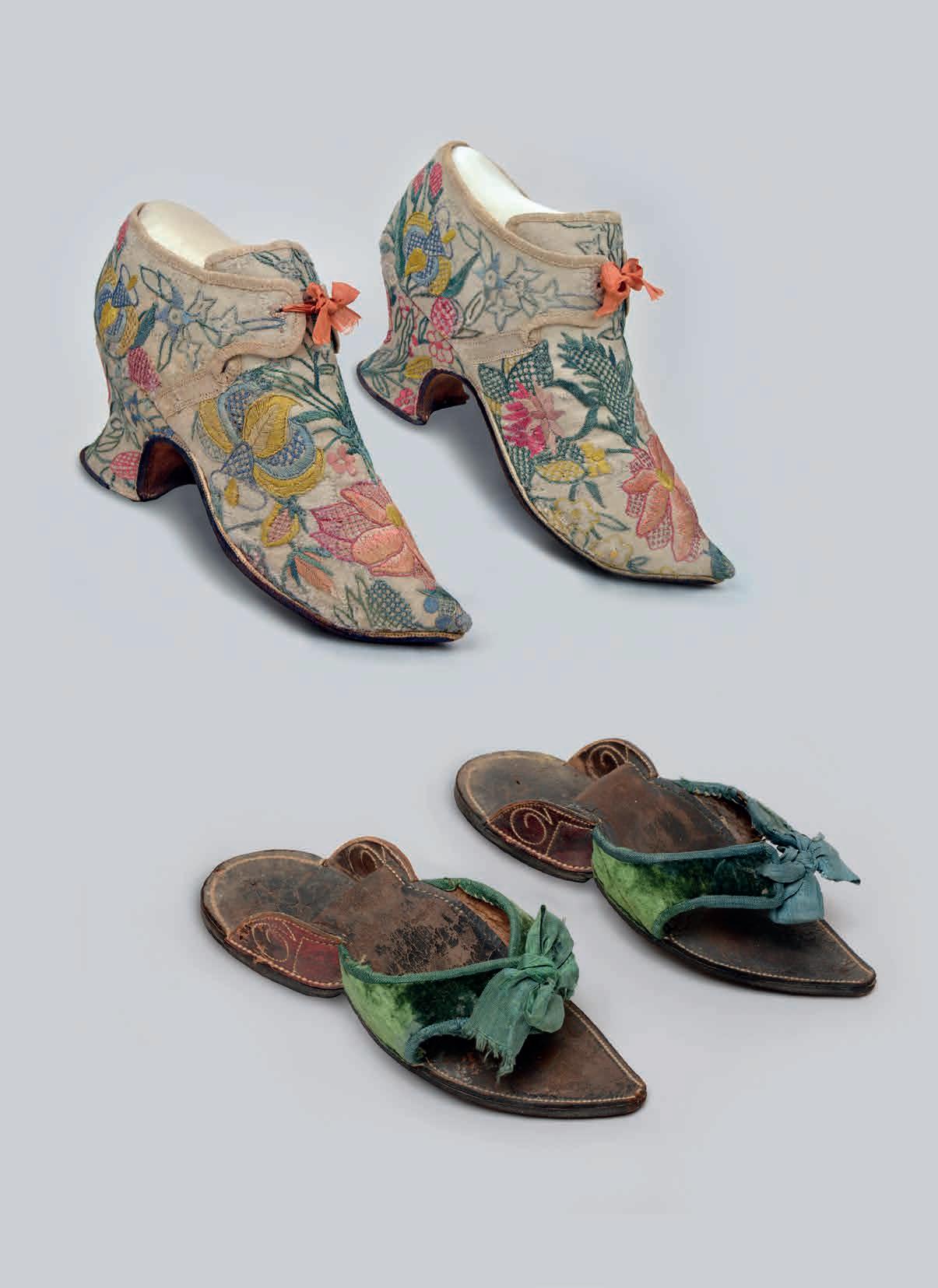
The cream wool twill ground of these early eighteenth-century shoes belies the vernal abundance of the flora, matched in mirror image across the pair, decorating their surface. Worked in no less than seven shades of silk floss, a variety of stitches (including satin, stem, tent, couching, rice, and fly) delineate English garden flowers mingled with more idiosyncratic blooms in a meandering pattern approximating locally produced brocaded silks. A large blossom—possibly a peony or poppy—dominates the vamps and heels, its petals worked in long-and-short stitches shading from peach to cream and underlaid with petals couched in geometric filling. Similar fillings complete the green serrated leaf above and the blue-and-yellow narcissi extending along the quarters, recalling contemporaneous English crewelwork bed embroideries, whose patterns ultimately derive from motifs in Indian painted cottons and embroideries. This springtime nursery is completed with stylized rosebuds, strawberries, and blue wildflowers creeping up the tongue and across the latchets tying at the front.
Initially drawn freehand by professional pattern drawers, embroidery designs for shoes could be found in books like Margaretha Helm’s Kunst-und Fleiss-übende Nadel-Ergötzungen oder neu-erfundenes Neh-und Stick-Buch (The Delights of the Art and Industry of the practicing Needle or the newly invented Sewing and Embroidery Book) by the 1720s. The motifs seen here, undoubtedly the work of an accomplished though nonprofessional embroiderer possibly taking inspiration from such sources, would have been intended as a personal demonstration of needlework prowess, which was one of the most important aspects of a woman’s education in the “gentle arts.” In Samuel Richardson’s novel Pamela; or, Virtue Rewarded (1740), skill with a needle is essential in the protagonist’s quest toward gentility; she writes in a missive to her parents, “I have been brought up wrong, as matters stand . . I must learn to flower and draw too, and to work fine work with my needle.”
Women often undertook such embroidery projects for garments in the period leading up to marriage. It is possible that these shoes were made to match an embroidered dress or other accessory. In The Spectator on October 13, 1714, James Addison cheekily urged mothers to teach their daughters to only entertain eligible suitors “but in a Suit of her own Embroidering” and to work a new stomacher for every reception. A note accompanying the present shoes in a later hand indicates that they were worn by a Mrs. Barbara Bearsworth at her wedding in 1777. This provenance is almost certainly erroneous given the shoes’ much earlier date of creation, but their rare survival may be linked to their function as a souvenir of a similar occasion some fifty years earlier.
Likewise, they may have served as a token of affection between a husband- and wife-to-be, a father and a daughter, or between sisters. For instance, Hannah Edwards and her sister together embroidered the shoes for her 1742 wedding, an example of such a rapport between siblings (Connecticut Historical Society, 1840.7.1a,b).
When the embroiderer had finished her fragile work, a professional cordwainer assembled it into sturdy footwear, with a white leather rand and kid lining, stout wooden heel, and tougher leather to form the rounded sole. Unusually, the uppers are lined with goldenrod-yellow linen and the tongues are faced with thinly striped taffeta, also suggesting that these were treasured possessions rather than practical accessories. An associated, though not matching, pair of pattens, in rich green silk velvet over leather and wood, accompanies the shoes. Such overshoes would have offered protection when the wearer ventured outdoors.
Embroidered shoes of this date are scarce, especially those in wool, which have been typically damaged by moths. A pair from the 1740s worked with crewels on a wool ground is in the collection of the National Museum of Scotland (A.1883.57, A.1883.57 A). A later pair with similar embroidery on a silk ground is at the Metropolitan Museum of Art (2009.300.1482).
9
TRAVELING MIRROR WITH EMBROIDERY AND RAISED WORK
English, third quarter of the 17th century
A seventeenth-century European lady of means embarking on a journey would have packed her clothing and jewels, and perhaps, for her personal vanity, also a traveling mirror. Luxuries to the fullest extent, mirrors themselves, made of silver-backed glass, were expensive commodities during this time, and, when encased within a needlework covering as in this rare example, the mirror’s embroidery and linings were also made of costly silk threads, fabrics, and metallic braids.
Prior to the mid-seventeenth century, skill in mirror making rested primarily with the Venetians, who exported mirror glass to England. Although domestic manufacture of mirrors existed in the early seventeenth century, it was not until the 1660s that the English become more proficient in the task, resulting in lower costs and greater availability among the elite. At that time, English women and girls began producing embroidered frames and covers for these newly acquirable, and desirable, articles.
The reflective surfaces of mirrors, in addition to lending themselves to various personal uses, also held metaphorical importance for artists and writers in the sixteenth and seventeenth centuries: mirrors symbolize self-reflection and introspection, along with distortion and deceit. With the correlation of mirrors to the human eyes and the sense of sight, the thematic appearance of the Five Senses on this traveling mirror case is apt.
While the senses were depicted on personal objects as early as the Anglo-Saxon period, notably on a ninth-century brooch that uses human figures representing the Five Senses, it was not until the thirteenth century that the senses become common allegorical motifs often represented by five animals—a monkey for taste, a stag for hearing, an eagle for sight, a dog for smell, and a tortoise for touch. The personification of the senses with humans is represented in sixteenth-century engravings, made in Antwerp, after works such as The Five Senses series by Frans Floris (1561), and Maarten de Vos (ca. 1600), as well as Abraham Bosse’s French set (ca. 1635). Following their proliferation on the continent, allegorical prints of the Five Senses appeared in England by the 1620s. It is from these engraved sources that needleworkers adapted this imagery, rendered with needle and thread on silk.
As is typical with seventeenth-century English embroidery for caskets, boxes, and mirrors, this piece is worked in silk floss on a silk satin ground, with raised work added to give dimensionality. While most related needlework elements were made for stationary mirrors, with the needlework framing the exposed glass, for traveling mirrors, the embroidered components provide a decorative cover for the wooden doors. The left door depicts a woman, holding two flowers in her left hand, to represent the sense of smell; on the mirror’s right door, a woman playing a lute symbolizes the sense of hearing. Along with these figural personifications, the monkey at the top left and the squirrel at the top right hold food to their mouths in allusion to taste.

While the expected flora, fauna, and architectural elements, including fountains with their own reflective connotations, surround the allegorical figures, at the mirror’s top a stalking chameleon clings to a branch. This creature is not often seen among the animals that typically appear on seventeenth-century English embroideries—such as the butterfly, snail, and caterpillar on this piece— yet chameleons and related reptiles are among the menagerie of motifs provided to embroiderers in pattern books. A Schole-House for the Needle (1624), by Richard Shorleyker, includes a simple outline of a salamander, and A Book of Flowers, Fruits, Beasts, Birds, and Flies (1662), published by Peter Stent, includes a highly articulated engraving of a chameleon.
Extant travel mirrors of this type are scarcer than seventeenth-century mirrors made to hang in interiors. This example, small in scale for easy transport, features an easel stand on its back for steady placement on a table. The inside panels are lined with salmon silk embossed with a diaper pattern and outlined with silver tape trim. Salmon silk velvet covers the reverse and sides. A comparable travel mirror, formerly in the collections of Percival Griffiths and Sir Frederick Richmond, illustrated in English Domestic Needlework, Therle Hughes, pl. 35, was sold at Bonhams, London, March 2, 2011, lot 1; another example from the Richmond collection is illustrated in The Connoisseur, May 1935, p. 282, and was sold at Christie’s, London, June 23, 1987, lot 133; and a third example is known in a private American collection.
11
11 ¼” H x 9 ¼” W
SILK DAMASK DRESS PANEL
PROBABLY DESIGNED BY ANNA MARIA GARTHWAITE AND WOVEN BY SIMON JULINS
English (Spitalfields), ca. 1741–43
Silk damasks produced in China, with dynamic and monumentally scaled patterns, seduced Western consumers from the seventeenth century. In order to show off the enormity of their motifs, these silks were often used for bed hangings, though they were quickly adopted for male and female attire as signifiers of exotic luxury. By the eighteenth century, in order to compete with these imported textiles, the English silk industry headquartered in Spitalfields, in East London, began to develop damasks specifically for dress that incorporated motifs from India, another Eastern trading center. Serpentine stems sprouting curling leaves and fanciful composite blossoms derived from Indian palampores and embroideries reappear in English damasks, blown up in scale and rendered in monochrome, allowing draftsmanship rather than vibrant pigmentation to command attention.
With its expansive swirling pattern of sinuously revolving lobed leaves and fleshy blossoms, this damask panel is a striking example of English silk weavers’ ability to transform Indian motifs into a new design idiom. Its vigorous asymmetry and gargantuan forty-one-inch vertical repeat, combined with the particularly smooth style of drawing, strongly recall the work of the most famous English silk designer of the eighteenth century, Anna Maria Garthwaite (1688–1763). Born in Harston, Lincolnshire, she was the second of three daughters of Reverend Ephraim Garthwaite and his wife, Rejoyce, and the only Garthwaite girl who remained unmarried. In about 1729, Anna Maria and her widowed sister Mary moved to Spitalfields where Anna Maria flourished as a silk designer for the next twentyfive years. At the height of her career in the early 1740s, she produced up to eighty designs per year, proudly collected and annotated by the designer in books, most of which—some eight hundred designs in total—are now in the Victoria & Albert Museum.
“Damask patterns require the boldest stroke of any; the flowers and leaves should always be large, and the small work omitted as much as possible, except it be in the middle of a leaf or flower,” wrote the author, widely held to be Garthwaite herself, of an article on silk design in Godfrey Smith’s 1756 The Laboratory, or, School of arts; the article also advocated use of “a bold stroke with the line of beauty,” seen here in the rhythmic meander of the central stem. If it was indeed designed by Garthwaite, this damask may have been woven by master weaver Simon Julins, one of her most loyal clients who advertised damask weaving as a particular specialty. Julins was the weaver of a silk, worn by Philadelphian
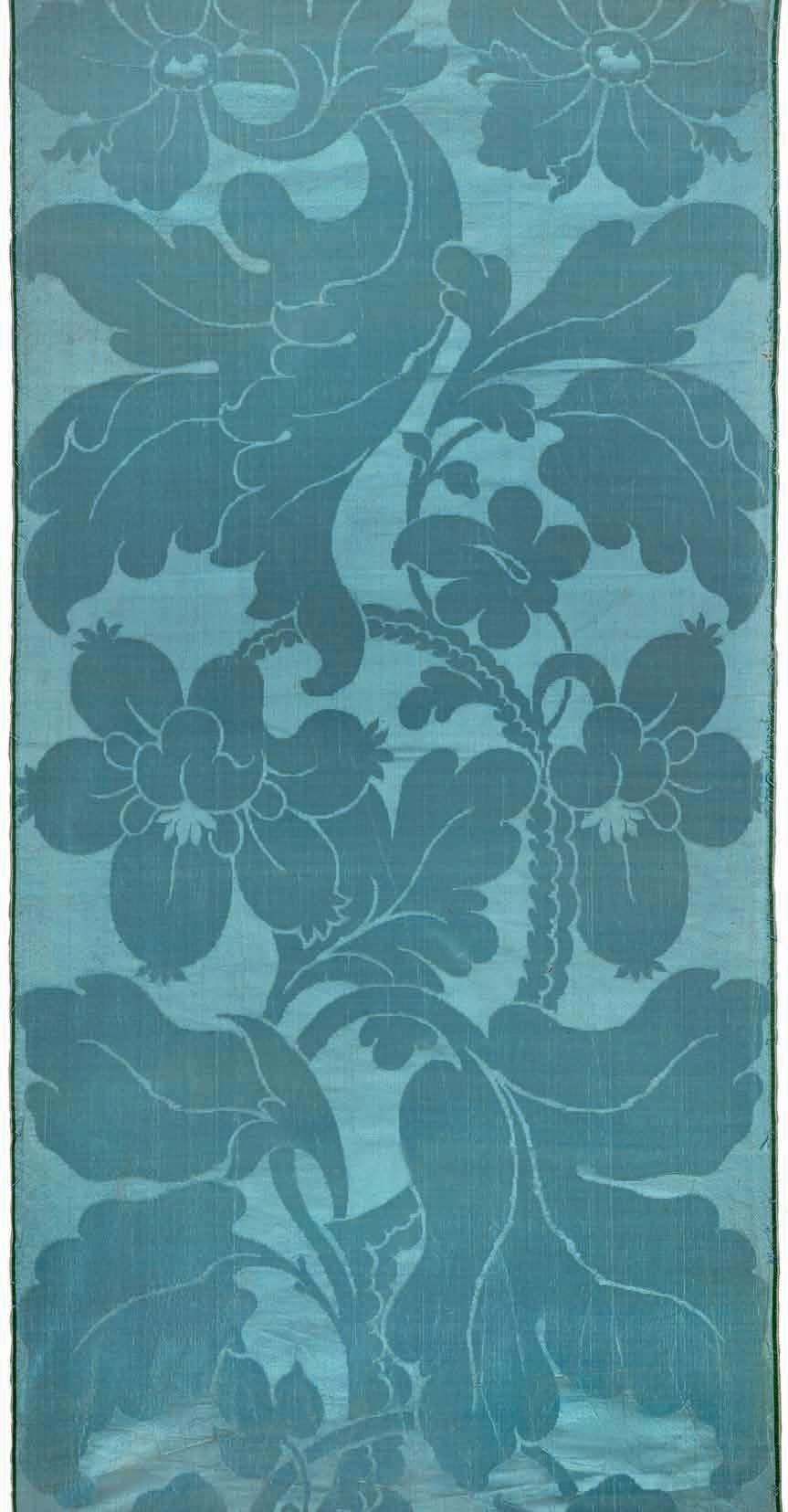
Anne Shippen Willing in a 1746 portrait by Robert Feke now in the Winterthur Museum (1969.0134A), rendered so faithfully that it could be identified with a Garthwaite design created three years earlier.
In colonial North America, silk damasks were called “India damasks,” a reference to the English East India Company that purveyed these silks rather than their geographic origin, as well as a habitual contraction of China and India. In 1744, Philadelphia dry goods firm Hamilton, Wallace, and Co. publicized its newest “Spittlefield indians for gowns,” likely referring to damasks such as this. In fact, the present design, very close to Willing’s damask, also has an established American history: panels of identically patterned damask in a fawn colorway that descended in the Dandrige family of Virginia, possibly part of a gown worn by Martha Washington, are in the collections of Colonial Williamsburg (G1975-342,1-4) and Mt. Vernon (W-2078). Damask’s versatility made it a favorite of British colonists in America, who, barred from legally acquiring the more fanciful polychrome brocaded silks produced in France, sought out the products of Spitalfields’ looms for their best wearing attire. On a practical level, damask is a perfectly reversible and durable weave structure, allowing garments to be “turned” after periods of use; an example of a complete turned dress is in the collection of Colonial Williamsburg (1941-257).
This panel bears striking resemblance not only to the silk depicted in Feke’s portrait, but also to several of Garthwaite’s unpublished designs for damasks created in the early 1740s with an audacious asymmetry (particularly 5976:14, 5978:16, and 5980:2 in her pattern books at the V&A). An identical length of blue damask, originally from the same dress as this panel, is in Winterthur’s collection (2004.53). Dresses of comparable Spitalfields damasks include those in the Museum at the Fashion Institute of Technology (P78.3.2); the Killerton Fashion Collection, Devon (NT 1360761); and the Museum of London (50.6/1).
12
41” H x 19 ¾” W
ROUND GOWN OF BROCADED SILK WITH MATCHING SHOES THE SILK POSSIBLY DESIGNED BY ANNA MARIA GARTHWAITE English (Spitalfields), ca. 1750–60, the silk ca. 1742–44
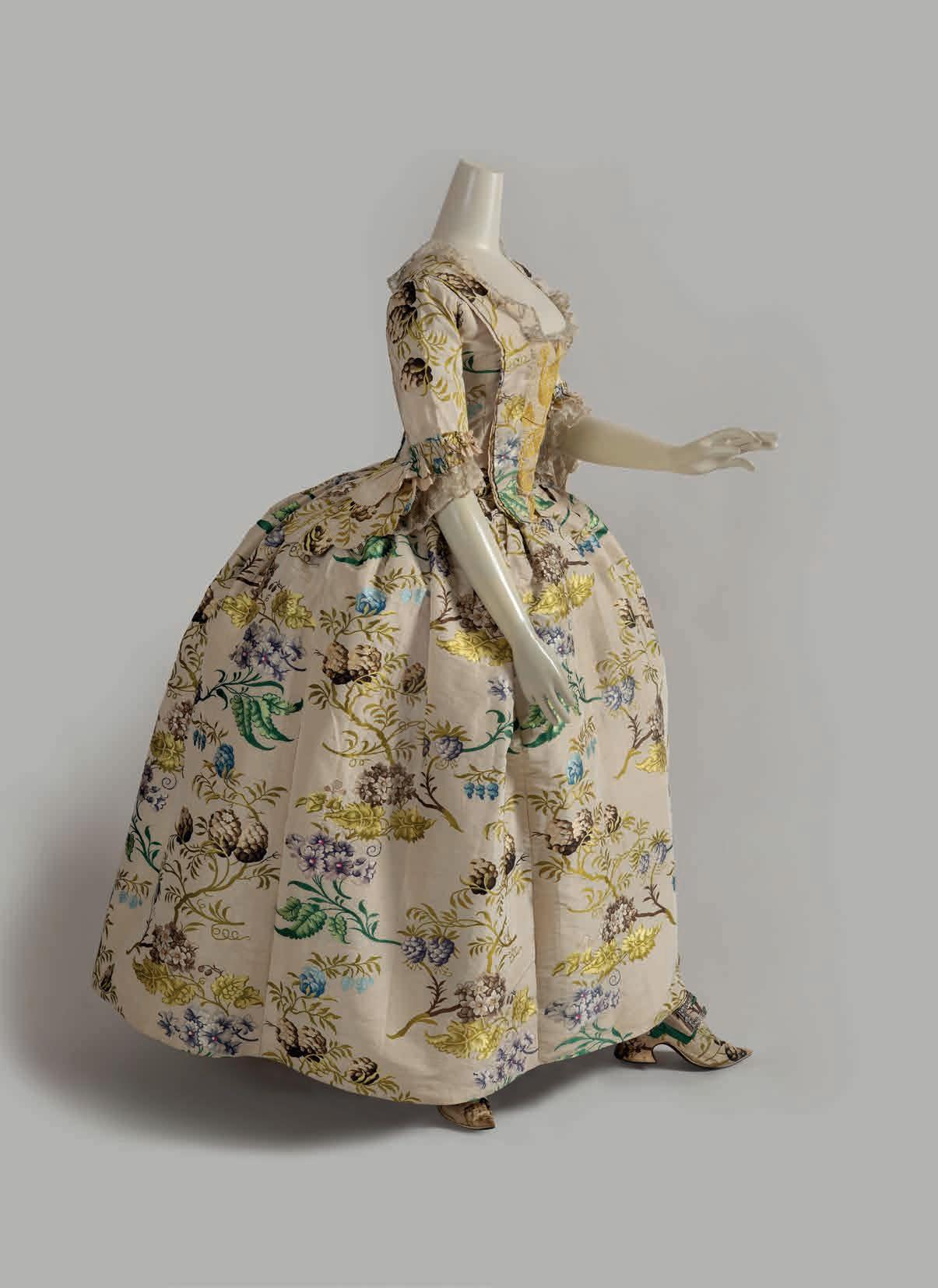
In the eighteenth century, Spitalfields was a bustling urban crossroads. Not only was the area in London’s East End the nation’s silk-weaving center, but also the site of established fruit, flower, and vegetable markets, reminders of the area’s former fields and gardens on lands owned by the priory hospital of St. Mary’s. The English silk industry initially looked to mainland Europe and the East for design inspiration, but, by the mid-eighteenth century, designers such as Anna Maria Garthwaite (see p. 10) capitalized on the proximity of fresh flora to create a distinctively English style that contrasted with the increasingly flashy silks being produced on the Continent.
A bespoke ensemble that has survived together in pristine condition for over 250 years, this one-piece robe à l’anglaise and matching shoes are a rare testament to the literal budding of a new national design lexicon. The textile from which both elements are made is one of the earliest examples of an unmistakably English style in silk, which began to emerge noticeably in about 1742, a date discernable thanks to Garthwaite’s meticulously compiled designs, now at the Victoria & Albert Museum. Possibly created by this most famous designer, the textile features stylized primroses commingled with blackberries that demonstrate a high degree of accuracy, sprouting curling elements known botanically as “styles,” and hops, the preferred bittering agent for beer, rendered in brown. Cultivated extensively in Kent and, like the blackberry, a summer crop, hops would have been familiar to Garthwaite and her fellow Spitalfields designers, who shared streets with breweries as well as flower stalls. Nevertheless, the inclusion of hop motifs is extraordinary, as only two other silks incorporating them are known (Victoria & Albert Museum, T.395-1977; Fanshawe mantua at the Museum of London, 83.531).
Fourteen different colors of brocading wefts were used to create the pattern on a warp-faced taffeta ground in a color known in the eighteenth century as “cloth,” with touches of butter yellow on the hops and a subtle crescent of magenta at the center of the purple flowers. In coloring and conception, it resembles silk designs by Garthwaite from 1742 (particularly 5980:3 and 5981:23 in her pattern books at the V&A, both unpublished) through 1744. Large fruits and berries are a common feature of her work from the 1730s, which by the following decade had been superseded by delicate overall floral compositions, making this silk a transitional exemplar of the new Spitalfields style.
Both the current dress and a “sister” dress of identical silk that descended in the same family (Gainsborough’s House Museum, Suffolk, 2017.134) are remade from an earlier garment, probably a formal mantua, which required between eighteen and twenty-five yards of silk. Precise seaming and fine sewing throughout this dress suggest the hand of a professional dressmaker used to working such thick, stiff silks into more relaxed and malleable forms. From a complex and rigid court style—working in concert with a skilled cobbler who ably mirrored the hop motif across the toes of the shoes—she crafted an informal dress made even more straightforward by the integration of petticoat and robe into a one-piece round gown. Scalloped-and-pinked double sleeve ruffles date the dress to after 1750, while the lack of elaborate self-trimmings suggest a date before the 1760s. The skirt and cuffs retain their original white China silk lining, an unusual feature for an English dress of this period. Eighteenth-century dresses and matching shoes rarely survive together. Examples include those in the Metropolitan Museum of Art (1994.406a-c); the Massachusetts Historical Society (1110 and 1111.01-02); and the Fashion Museum, Bath (2018.50).
Provenance: The set descended as part of the Strickland family heirlooms at Sizergh Castle, Cumbria. While the original wearer of this dress and shoes is not known, one intriguing possibility is that the silk from which these pieces are made formed a garment belonging to Mary Bagenal (ca. 1706–1744), wife of Jarrard Strickland (1704–1791), head of the junior branch of the family residing in York. Before her early death, she bore her husband a son and heir, Jarrard Edward Strickland (1741–1795)—from whom descended the eventual inheritors of Sizergh—as well as two daughters who remained unmarried, Mary and Cecelia. Little else is known of their lives, but it is possible that their mother’s dress was utilized to make two matching dresses.
15

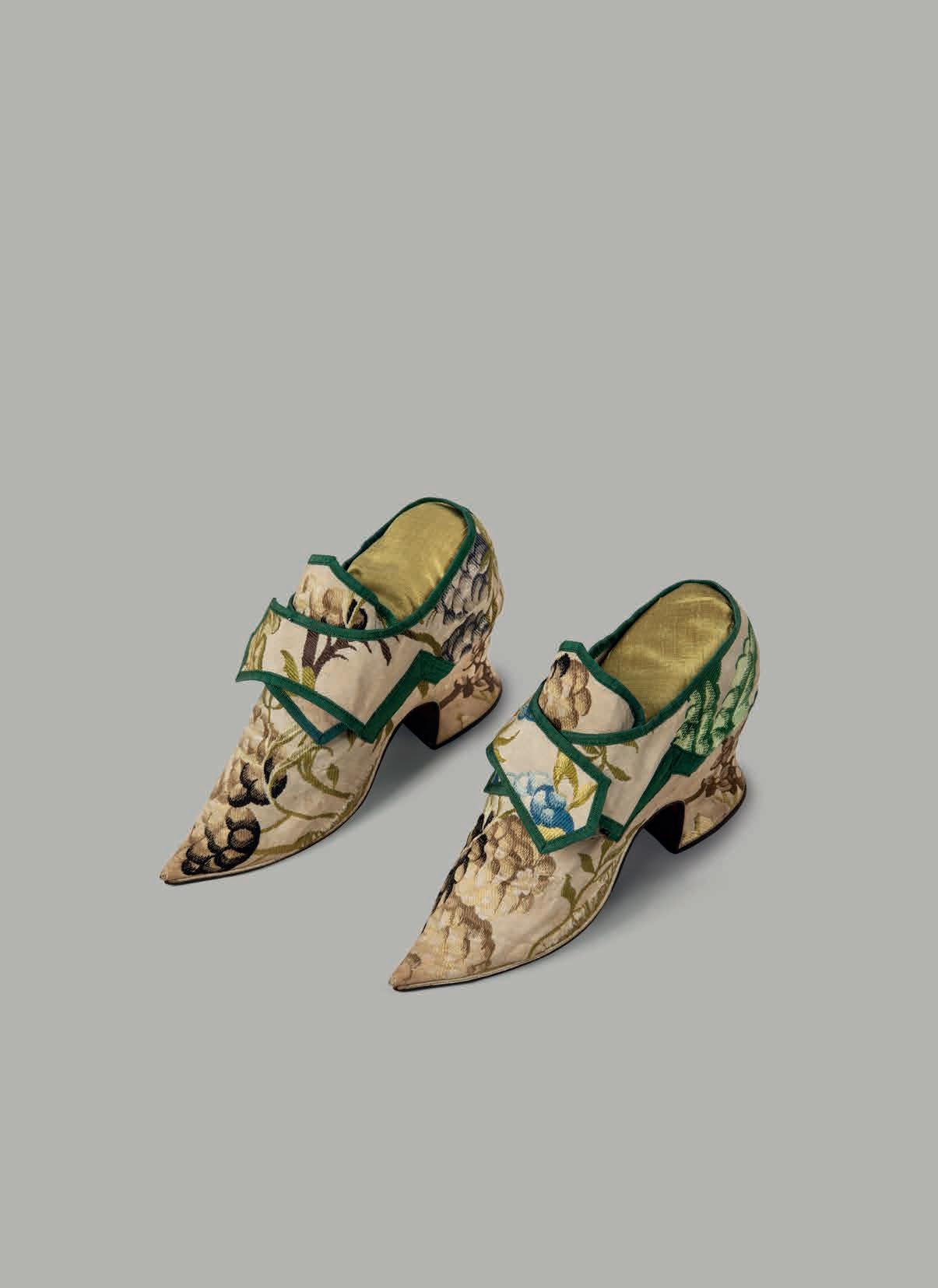
RENAISSANCE-REVIVAL SATIN, GAUZE, AND SILVER PASSEMENTERIE FANCY DRESS English, ca. 1820
The reciprocal relationship between women’s fashionable and fancy dress and the pronounced influence of historical styles in the early nineteenth century are evident in this splendid Renaissancerevival costume. Although fancy dress balls were popular throughout the nineteenth century, intact examples from the first half of the century are exceedingly rare because of the ephemeral nature of these specialized garments, which were intended to be worn only once and were often, as seen here, made of fragile materials. It is also exceptional to know the provenance of this gown, which descended in the Strickland family of Sizergh Castle, Cumbria.
This eye-catching confection comprises a bodice of coral-pink silk satin laced at the center front with a silver cord and an overskirt of ivory silk gauze, generously trimmed with olive-green satin, ivory tulle, swags of silver fringe, silver tape and scalloped bobbin lace, and a large pink-and-green silk bowknot, festooned with gleaming silver tassels and silver cord looped into a bow. The jaunty, conspicuous tabs over the shoulders and around the waist deliberately evoke similarly placed—though less prominent— decoration on doublets from around 1600. By 1815, the neoclassical influence that had defined the pared-down silhouette of women’s dress since the turn of the century was increasingly replaced by a fuller, A-line shape that incorporated elements of fifteenth-, sixteenth-, and early seventeenth-century fashions. Here, the high waist, frothily gathered gauze sleeves, and gently flared underskirt, held out at the hem by a pink-and-green satin band with padded edges (carefully reconstructed), suggest a date of about 1820.
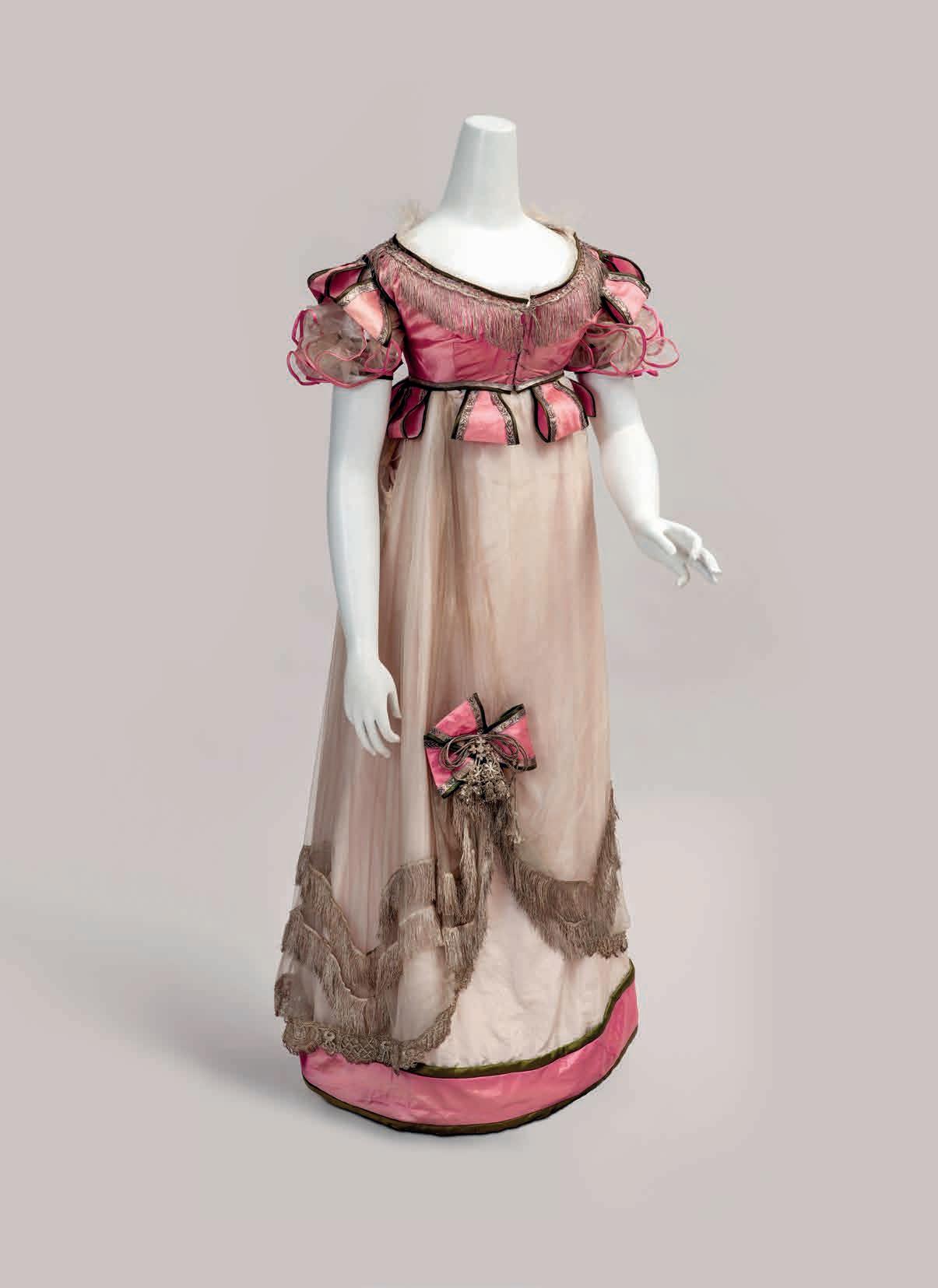
The materials and color combination in this fancy dress correspond to fashionable evening wear of the period. Multiple illustrations and descriptions in Ackermann’s Repository of Arts, Literature, Fashions, Manufactures, &c and La Belle Assemblée confirm the vogue for white or colored gauze over matching or contrasting silk slips. The text accompanying an Ackermann’s plate, from April 1819, details “a white gauze round dress over a white satin slip,” and its tight-fitting corsage of pale pink satin and white lace with “Spanish style” sleeves of “white lace . . . slashed with pale pink satin.” In September the following year, Ackermann’s also illustrated a ball dress with a lace skirt, open on the left side over a pink satin slip, similar to the draped effect seen here, and still-fashionable pink-and-white slashed “Spanish” sleeves. Instead of the self-fabric, ribbons, and other delicate trimmings that adorned fashionable evening attire, however, the substantial application of rich silver passementerie on this gown clearly indicates fancy dress. In July 1819, La Belle Assemblée reported on the ensembles worn by female participants at the Prince Regent’s fancy dress ball that, in accordance with his wishes, reflected the “costumes of different nations.” The descriptions of Andalusian, Neapolitan, Swiss, Milanese, Cossack, Tyrolese, and Russian costumes document the lavish use of silver edging, gold trimming, gold and silver lace and fringe, cordons and upper sleeves of silk and gold, and gold tassels. A “Swedish Dress” of “white crape over white gros-de-Naples” featured a “cerulean blue corsage, laced in front with silver and the waist encircled by a silver cord,” similar, perhaps, to this bodice.
In addition to fashion periodicals, prints and, more uncommonly, paintings record early nineteenthcentury fancy dress. A caricature titled “Tom & Bob Sporting their figures at a Fancy Dress Ball,” from Real Life in London (Volume II, 1822), presents a group of dancers and other guests at London’s fashionable Almack’s Assembly Rooms in oriental- and Elizabethan-inspired costumes. William Etty’s portrait, Preparing for a Fancy Dress Ball (York Art Gallery), shown at the 1835 Royal Academy Summer Exhibition, depicts Charlotte and Mary, daughters of the Welsh politician Charles Watkin WilliamsWynn, in remarkably similar fancy dress of high-waisted, sleeveless satin bodices over white silk underdresses with short, full sleeves. Mary’s silver-edged blue bodice has a center front opening and tabbed hem, resembling this one; Charlotte’s is trimmed around the waist with looped gold fringe.
Although it cannot be established with certainty which female member of the Strickland family wore this gown, it is tempting to imagine her like the young woman at her toilette in the so-called Inlaid Room at Sizergh Castle in an engraving from the 1835 publication, Westmorland, Cumberland, Durham, and Northumberland Illustrated. The late Tudor bedchamber, with its elaborately carved wood paneling and plasterwork ceiling, would have been the perfect setting for the wearer to complete the final adjustments to her superb revival costume.
Provenance: Sizergh Castle, Cumbria
19
SILK-EMBROIDERED SATIN COVERLET English, ca. 1720–30
In English needlework of the seventeenth and eighteenth centuries, the male world of scientific knowledge overlapped with the female sphere of domesticity. From the publication, in 1597, of John Gerard’s The Herball, or generall historie of plantes, containing more than one thousand species and considered to be the first catalogue of plants, to later compilations by upper-class English women—such as Mrs. Mary Delany, who, in the 1770s, created a florilegium, Flora Delanica, using cut paper to depict flowers with scientific accuracy, each example marked with its common and Linnaean name—the confluence of botanical information with the domestic art of embroidery led to highly accurate yet decoratively interpreted notions of flora.
Knowledge of the natural world quickly found its way to many possible applications, including providing an abundance of botanical motifs that could be used in embroidery patterns, bringing the pleasures of the garden into domestic spaces. Within the domains of aristocratic life, luxurious hangings and coverlets, made to adorn beds and walls, often displayed specimens from the vast catalogue of known plants of the time, complemented with examples that could never be found in nature. As seen in this beautifully embellished coverlet, both types of specimens, from botanically accurate to wildly fanciful, were expertly rendered in silk threads.
The rich polychrome colors used to embroider this remarkably preserved coverlet, stitched on a silk satin ground, retain their brilliance today. The arrangement of floral motifs follows a classic composition—a central medallion with corner elements surrounded by a wide border—that derives from Persian, Indian, and Chinese carpets. This patterning found its way to European decorative arts when the circulation of items made in the East for distribution in Western markets, beginning in the sixteenth and seventeenth centuries, resulted in the crosspollination of design elements. Within the prescribed placement of motifs, the embroiderer’s high level of skill can be seen: in the central field, roses dominate the floral sprays in two opposing corners, and carnations in the other two. While each pair is similar, distinct details of coloration and a sophisticated assortment of embroidery treatments mark each spray. Within the central medallion and border, the variety of flowers expands to include lilies, pansies, honeysuckle, and borage, all worked in twisted silks primarily in long-and-short and stem stitches. A highlight of this coverlet is the diversity of filling stitches within the depictions of petals and leaves that pattern the elements in unique ways—a tour de force of embroidery skill and creativity. Seventeenth- and eighteenthcentury bedcovers were sometimes created in sets of graduated sizes; the small scale of this example suggests it was used either as a cradle cover or as a bearing cloth.
While many of the flowers embroidered here would have appeared in Gerard’s book, as well as in actual English gardens, scientific knowledge went hand in hand with the commonly known allegorical language of flowers, where romantic ideals of nature mixed with biblical notions of the Garden of Eden. Additionally, the Eastern tradition of flora as a prime subject for embellishments of fantasy adds another perspective to the connotations of flowers. This commingling of the natural world with imaginative elements can be seen in the patterns for needlework by Margaretha Helm found in her Kunst-und Fleiss-übende Nadel-Ergötzungen oder neu-erfundenes Neh-und Stick-Buch (The Delights of the Art and Industry of the practicing Needle or the newly invented Sewing and Embroidery Book), ca. 1725, where recognizable flowers mix with those both stylized and fantastical
In needlework of this period, the skill in rendering lifelike flowers is often matched by the creativity of embroidering floral elements where no guidelines exist in nature. On this coverlet, a passion for cataloguing the natural world includes an expansive view where the natural symmetry of a leaf is forsaken for a stylistic depiction: one side demonstrates complex shading in satin stitch while the other demonstrates a sparse network of veins in a single shade of green silk. It was the prerogative of the embroiderer to amplify nature while luxuriating in its almost infinite variety.

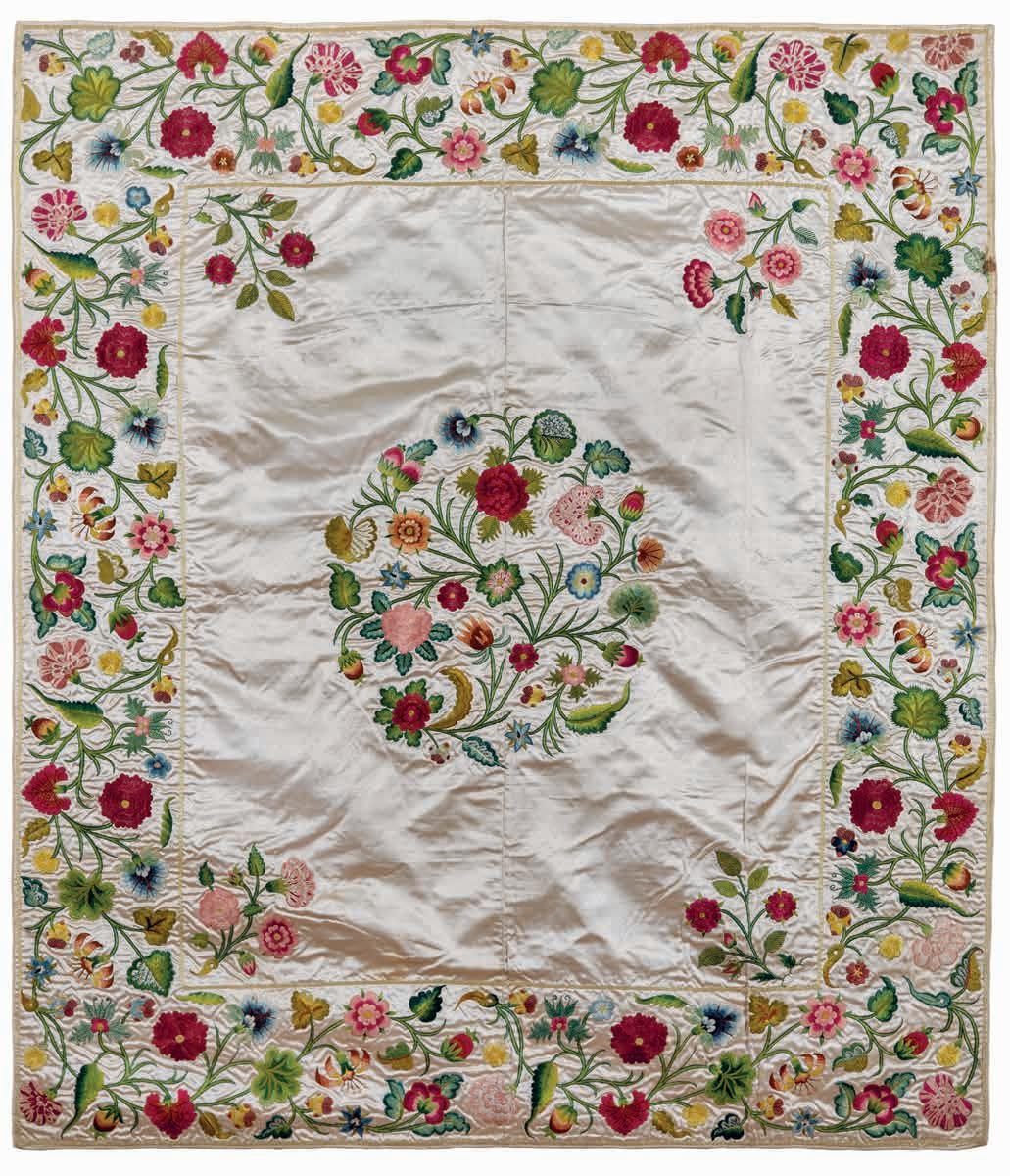
20
44 ¾” H x 40” W
PAIR OF BLOCK-PRINTED COTTON DRESSES ONE FASHIONABLE AND ONE FOR MATERNITY English, ca. 1798–1803
Before the introduction of maternity wear as a distinct category of clothing in the early twentieth century, women modified their existing garments to accommodate their changing bodies for pregnancy and nursing. Worn at a time that was potentially dangerous for both mother and child, maternity clothes were primarily functional and only very rarely saved. The survival of these matching printedcotton dresses that likely belonged to the same woman, one intended for maternity, is remarkable. In contrast to the rigidly corseted, conical shape, and heavy silks fashionable during most of the eighteenth century, the high-waisted cotton gowns in style at the turn of the nineteenth century were considerably more comfortable for expectant women. This pair of dresses tells a moving and important, but often lost, story about the lives of women for whom the expectation of childbirth brought joy and unknown risk.
Although both dresses are made from three fabric lengths, each thirty-five-inches wide—one across the front and one at each side, joined at the center back—the construction of the bodices is purposely different. Tellingly, the maternity dress is made without a waist seam; the front panel extends from shoulder to hem, with an opening on the proper left side to below the bust, and the upper corners fold back, forming a wide V-neckline. The excess fabric at the side seams under the arms is gathered into inverted pleats above a pocket slit and tightly cartridge pleated across the short center-back bodice seam. A narrow white cotton belt, attached at the back waist, gently gathers in the fullness of the front panel under the bust. In the maternity gown’s mate, the overlapping bib-front bodice that fastens with small white Dorset buttons at the top of the shoulders is cut separately from the skirt panel, as are the side and back bodice pieces. A finely ruched self-fabric band subtly edges the back neckline. In both gowns, the wide necklines are secured by interior cotton cords looped over buttons at the sides of the bust. The dresses also feature two-part elbow-length sleeves with full, draped upper sleeves set in over the shoulder blades, creating the diamond-shaped back characteristic of bodice construction in the late eighteenth and early nineteenth centuries. While the two dresses are fashionably trained, the rounded train of the maternity gown—presumably in a nod to practicality—is six inches shorter than the rectangular shape of its twin.
Caricaturists frequently targeted the so-called nude look of this clinging, columnar silhouette. A 1796 print by James Gillray titled “The Fashionable Mamma, or, The Convenience of Modern Dress,” satirizes both the ease of access to the female body afforded by these unconstructed gowns and the Jean-Jacques Rousseau-inspired trend for breastfeeding among the upper classes. While her carriage and liveried servants (visible through a window) wait outside, a young aristocratic woman, attired for an evening occasion in a turbaned headdress with outsized pearls and towering ostrich feathers, disinterestedly nurses her baby, held to her breast by a maidservant. The pocket slits of her short-sleeved, trained dress—humorously placed over her bust—provide “convenient” openings for the baby to feed.
Short, full oversleeves, or epaulettes, caught up with buttons, cords, or tassels, over wrist- or elbow-length undersleeves appear regularly between 1800 and 1803 in morning and afternoon dresses in Nicolas Heideloff’s Gallery of Fashion. A plate from April 1798 illustrates an afternoon dress with “the upper part of the scarlet sleeves cut out in diamonds, and trimmed with beads,” similar to the buttoned oversleeves of the non-maternity gown. The small pleats, or “plaits,” on its undersleeves were also a construction feature, used to control fullness around the upper arm.
The fabric’s delicate, monochromatic design of softly cascading grasses complements the gowns’ understated elegance. Although stylized in its rendering, the depiction of seed-laden stalks is particularly appropriate given the use of this cotton for a maternity gown. Printed on fine, plain-woven cotton, the motifs’ sharp delineation was achieved by woodblocks set with copper strips and pins of different diameters. This technique was associated with London-based printers who continued to practice the more expensive hand blocking of high-end cottons that remained fashionable among affluent female consumers into the 1810s. In Lancashire, however, the heart of the rapidly expanding cotton manufacturing industry, printers increasingly used engraved copper rollers to maximize output and reduce manufacturing costs. Two early nineteenth-century pinned and coppered blocks owned by Turnbull Prints, in Stubbins, Lancashire, that were acquired from David Evans silk printers, show similar trailing floral and foliate patterns: one with paired pendant blossoms (F10692), the other featuring oak-like leaves with a beaded central vein (F10864).
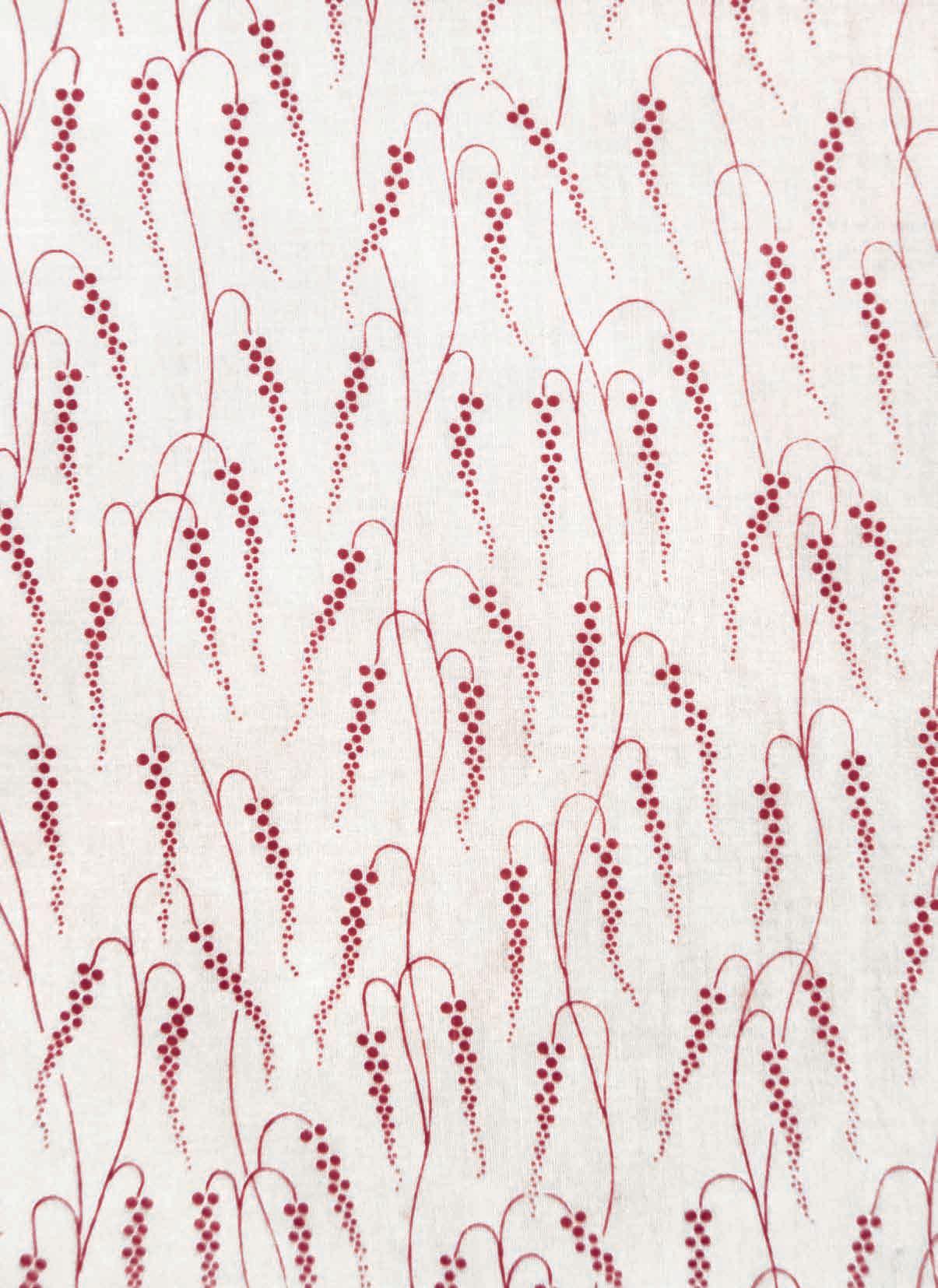
23
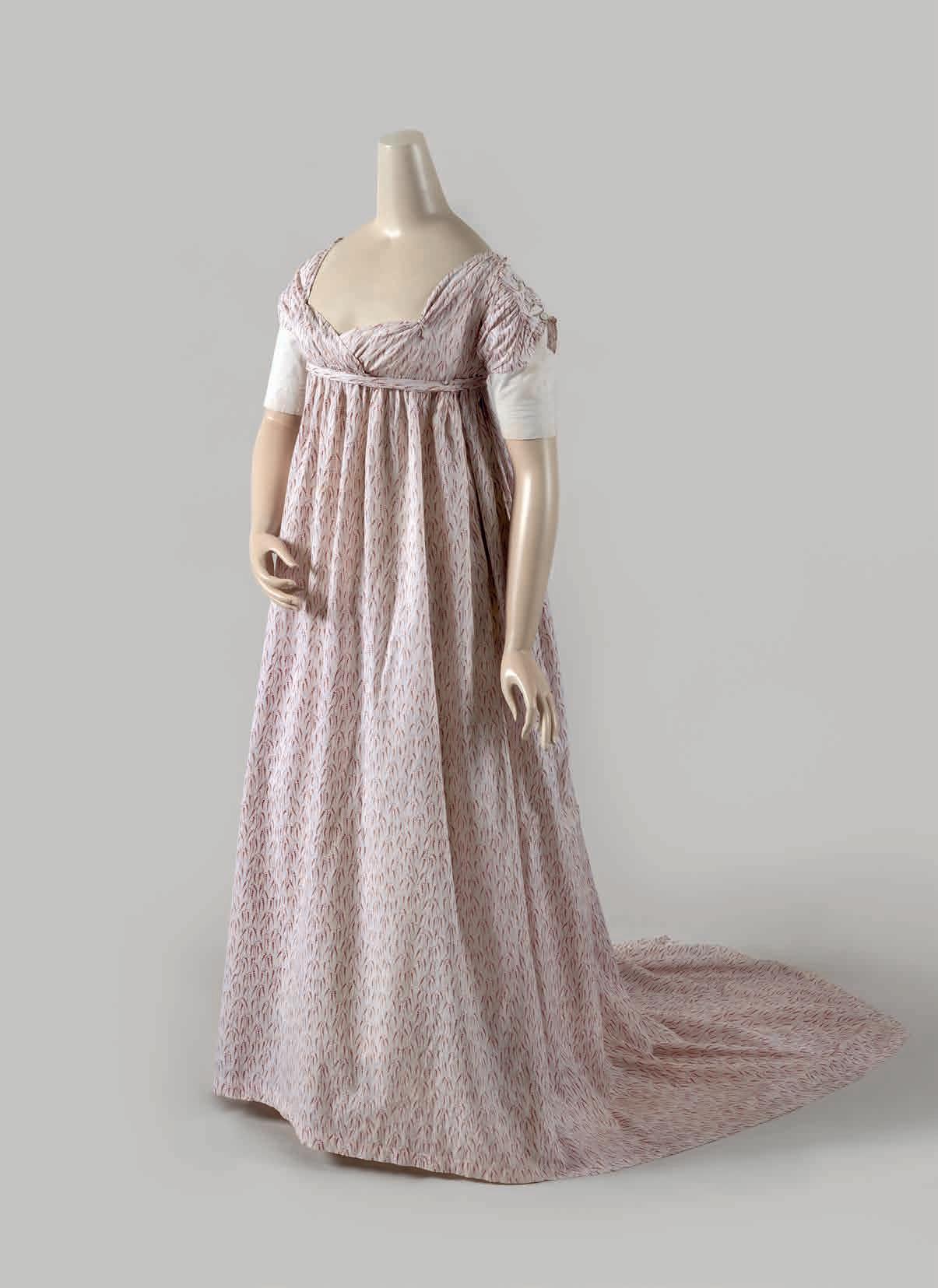
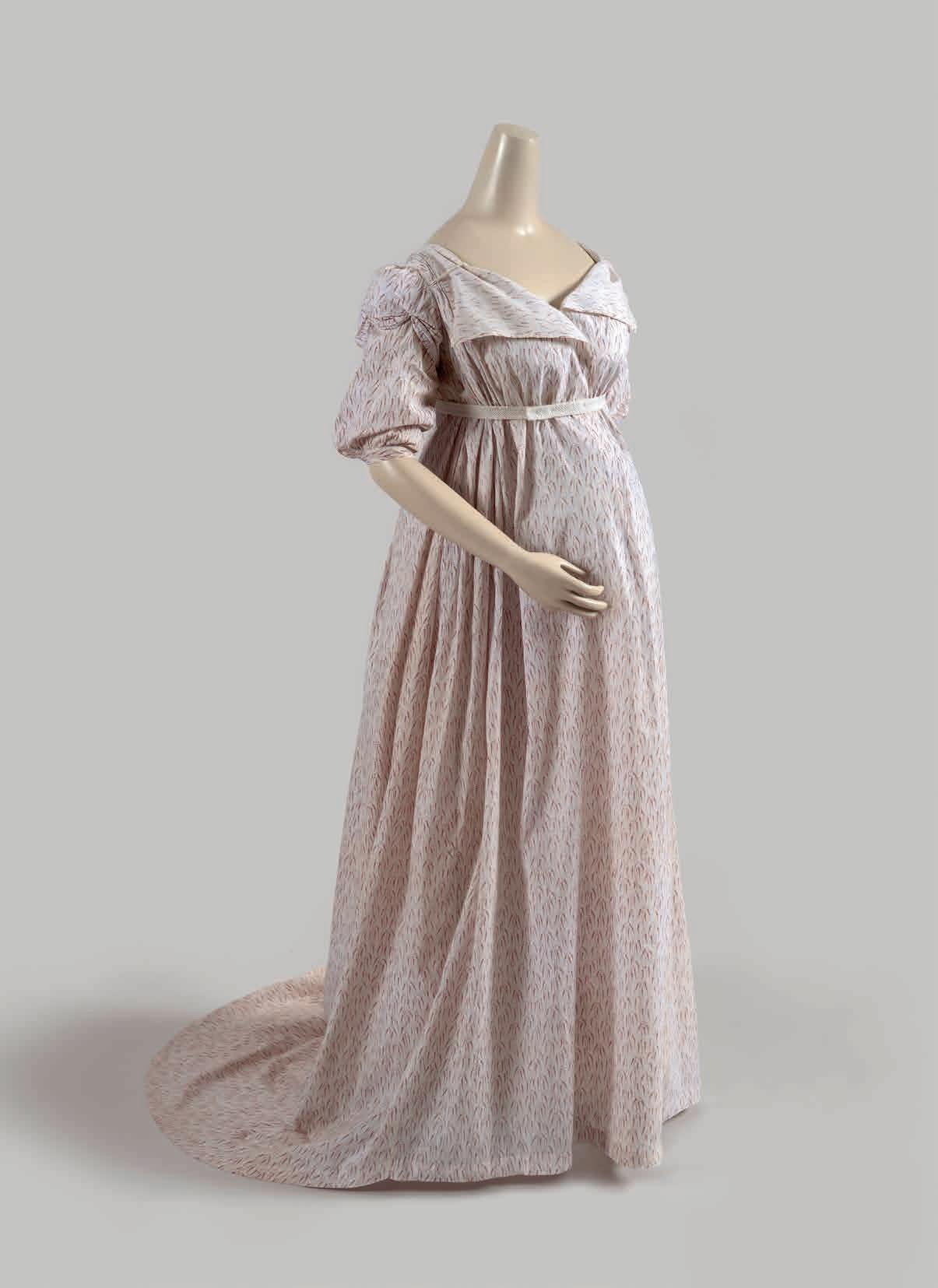
PORTFOLIO OF BLOCK-PRINTED COTTON SAMPLES MANUFACTURED BY NICOLAS DELLOYE
French, 1806
This collection of thirty-three pristine printed-cotton samples, preserved in their original portfolio dated 1806, offers a rare glimpse into the multifaceted business activities of a Liègeois entrepreneur in the early nineteenth century. Manufactured by Nicolas-Aimé-Antoine Delloye (1755–1818) in Huy (in modern-day Belgium) and shown at the fourth Exposition des Produits de l’Industrie Française in Paris that year, the samples represent what seems to have been a new and experimental venture for him. Interestingly, the enterprise for which he is primarily—and frequently—cited in the annals of industrial manufacturing during this period is tin ware. One of the many reports published at the time of the exhibition, Notices sur les objets envoyés à l’exposition des produits de l’industrie française, listed Delloye’s contributions as paper, cotton samples, and sheets of tinplate, stating that the latter “came from a factory whose operations began this year.” It may be that the financial success of the Delloye family’s long-established papermaking firm allowed Nicolas to invest in other areas of manufacture, despite the high risk of failure or bankruptcy. A prominent citizen of Huy, Delloye was twice mayor (1799–1800, 1809–15) and served as a member of its municipal council (1803–15) during the two decades when the city was under French control (1795–1815).
The samples constitute a vivid display of the myriad small-scale floral and geometric designs that were highly fashionable for women’s dress and accessories at the beginning of the First Empire and attest to the increasing demand for printed fabrics. Described as toiles peintes, or painted cottons, on the portfolio’s flap and in the Notices, they are, in fact, block printed on sturdy, plain-weave cotton. The patterns encompass dense stylized floral and vegetal motifs on dark grounds; small sprigs in offset rows, delicate trailing vines with berries and flowers, feather-like motifs, and Indian-inspired blossoms on white grounds; as well as stripes, checks, ovals, and dots, all in shades of red, dusty pink, blue, brown, yellow, olive, aubergine, and black. Delloye was certainly well informed about what was currently in vogue among French consumers: both indiennes and mignonettes, or “miniatures”— geometric motifs in limited colors—were mainstays of the renowned Jouy manufactory southwest of Paris. In fact, Delloye’s cottons are comparable to those found in two albums compiled by Jouy’s founder, Christophe Oberkampf and now in the collection of the Musée des Arts Décoratifs, Paris. One of these comprises paper impressions from the Jouy manufactory dated 1805 (Recueil des premières empreintes de dessins pour la fabrique d’étoffes imprimées d’Oberkampf à Jouy. An XII; Inv. A A 20); the other contains samples from foreign printers, including English and Indian, dated 1760–1800 (Echantillons étrangers de Toiles-peintes recueillies par Oberkampf dans le cours du 18e siècle de 1760 à 1800 ; Inv. DD82 5306). A sample from the portfolio with yellow-and-black windowpane checks on a brick-red ground is strikingly similar to the fabric seen in a dress bodice dating to about 1820, possibly made from an earlier cotton, also in the Musée des Arts Décoratifs (UF 49.32.166).

Delloye’s red wax seal, with his entwined initials surrounded by a leafy garland, secures a narrow linen tape threaded through one end of the cottons. Pinned to the top sample is a small piece of paper with the inscription “Ourte No. 68,” indicating the name of the department in which Huy was located while part of the French Empire. A sample with intersecting wavy lines includes the chef de pièce with the information “Impression de G. Demer et N. Delloye à Huy,” referring to Delloye’s business partner, about whom little is known. Stamps with their individual initials appear on two separate cottons and may identify patterns owned individually by the two men. Other stamps with letter abbreviations and numbers are likely block printers’ marks and references to pattern books.
It is unknown how long Nicolas Delloye’s cotton manufactory remained in operation. Despite the sophistication of these prints—crisp and with a refined color palette—this particular enterprise was likely short lived, a casualty of market volatility. References in French scientific journals in 1809 and 1810 focus exclusively on Delloye’s lucrative tinsmithing achievements, including a three-thousandfranc prize that he was awarded in 1809. When Napoleon and his new wife, Empress Marie-Louise, visited Huy not long after their marriage in 1810, they were shown tin ware products from Delloye’s factories. The Delloye family’s involvement in Huy’s metallurgy industry continued into the second half of the nineteenth century.
A treasured compendium and a record of Nicolas Delloye’s participation in the first industrial exhibition that took place after Napoleon became emperor, the portfolio remained in the possession of his descendants until 2018.
Approximate measurement range: 8 ½” H x 7” W to 19” H x 11” W
26
HIKESHIBANTEN (FIREMAN’S COAT)
Japan, probably late Edo period (mid-19th century)
In an effort to protect buildings from the threat of fires in the essentially wooden capital city of Edo, the profession of the firefighter was divided into three ranks: daimyo (feudal lords); samurai; and machibikeshi, municipal firefighters who were appointed beginning in 1720 to service townspeople. Elaborately painted-and-quilted cotton hikeshibanten like this example, of a type popularized during the Edo period, were worn by machibikeshi, distinguishing them from daimyo and samurai who donned leather.
Typically, hikeshibanten featured an allover design of apotropaic symbols as well as literary and mythological references intended to empower and protect the wearer. They also referenced the identifying tattoos of Edo-period firefighters recorded in Ukiyo-e prints and early photographs. The heroic exploits depicted across this garment were well known from Japanese literature and print culture. The central male figure with a sword between his teeth, his own trunk richly tattooed, is Rorihakucho Cho Jun from the Suikoden, the Japanese translation of the fourteenthcentury Chinese novel Shui Hu Zhuan (108 Stars of Destiny). Rorihakucho Cho Jun (Zhang Shun in the Chinese original) has here been adapted from Utagawa Kuniyoshi’s famed woodcut (ca. 1827–30) depicting him breaking through Yongjin water gate, a torrent of arrows heading toward him, foreboding his imminent death.
Here, Rorihakucho Cho Jun’s final moments have been altered to effect a more triumphant finale. The coat’s artist omitted the fatal arrows, suggesting that the protagonist lives— encouragement for the wearer—but included an extraliterary character: a red-faced, demonic male nearly drowning. Out of breath, and with head and hands barely above water, the unidentified figure sinks under the hero’s feet. Behind the defeated enemy’s head, an open book crashes against the bright blue streaks of waves. This victorious passage might have served to imbue the wearer with his profession’s necessary gallantry.
Extending over the front of the garment, blooming peonies—fitting symbols of bravery, honor, and bravado—float in calmer waters. Completely reversible, these coats bear simpler geometric motifs on their reverses, along with heraldry of the wearer’s family or firehouse, or an auspicious phrase. The decoration on this coat’s reverse features an alternating diamond pattern and the characters that may denote the fire brigade’s name. The characters 嘉奈津 , on both lapels, likely refer to the brigade’s location and are possibly a phonetic rendering of Kanazu, a town in the Fukui prefecture.

Entirely hand sewn, this coat is constructed from layers of cotton quilted together using the sashiko technique to create an allover running stitch in tightly spaced parallel lines, with the complex scene hand painted in a variety of pigments. Tsutsugaki, a resist-dyeing method, was used to create the reverse’s geometric design. A paste of rice flour, lime, and water was drawn on the cloth with a paper tube (tsutsu), then brushed while still wet with soybean liquid to seal it. Once dry from the indigo dye bath, the paste was washed off, revealing the undyed (white) cotton.
Hikeshibanten, along with pants, hood, and gloves, protected firemen who, before entering a blaze, were doused in water. Some scholars believe that firefighters wore such coats with the plainer side visible, the interior pictorial program thus closest to the body in a talismanic gesture. While some extant painted-and-quilted hoods and gloves have evidence of fire damage, elaborate coats like this one were probably not worn “in the line of fire” but when paying condolences to victims’ families, on formal occasions, and at town festivities where firemen performed acrobatic entertainments.
In the Edo period, the laborious work of making a hikeskibanten was done domestically. Under the Meiji government, professionalization of this art led to simplified designs and machine-sewn construction. As tradition shifted in the early twentieth century, handmade hikeshibanten like this one became associated with Mingei, the folk-crafts movement championed by theorist Yanagi Soetsu to elevate the cultural status of functional, anonymously produced Japanese objects.
A coat in the John C. Weber Collection depicts Rorihakucho Cho Jun from Kuniyoshi’s woodcut. Hikeshibanten with protective, figural iconography include examples in the collections of the Brooklyn Museum (84.203.1); Denver Art Museum (1999.265); Honolulu Museum of Art; Indianapolis Museum of Art (2003.4); Morikami Museum and Japanese Gardens, Delray Beach, Florida; Peabody Essex Museum, Salem, Massachusetts; Philadelphia Museum of Art (2000-11314); Sumi Collection, Kyoto; and Victoria & Albert Museum (FE.107-1982).
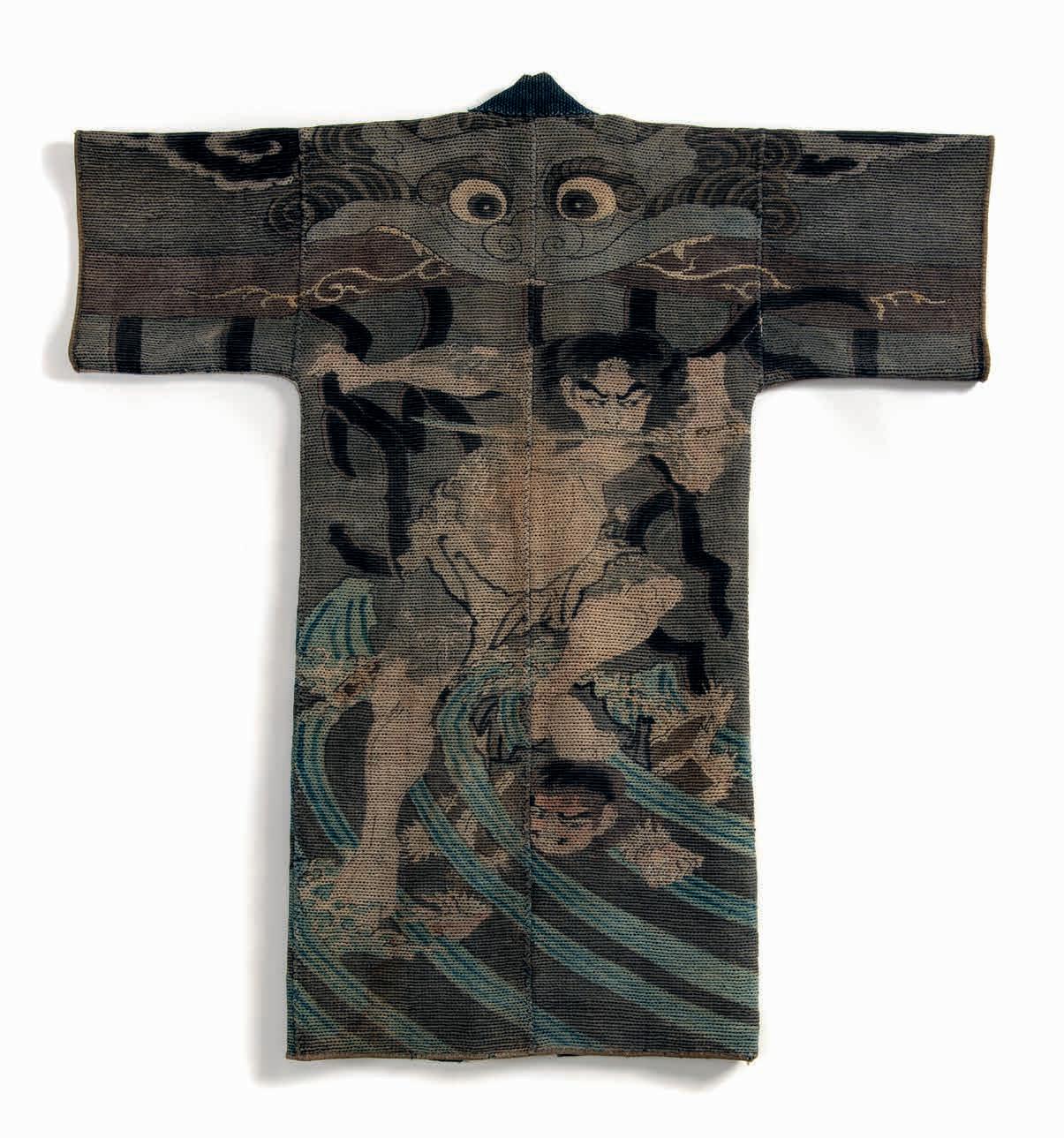
28
























